#and that you can actually climb up the cathedral from the town square below
Text
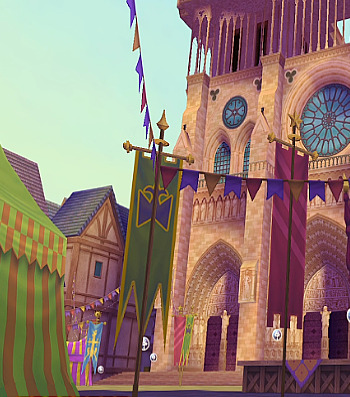

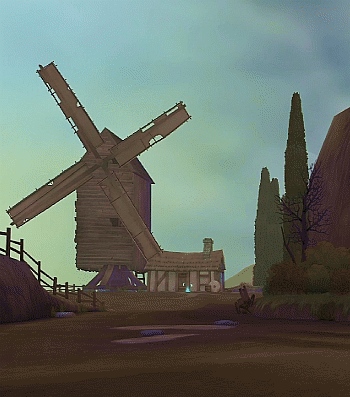
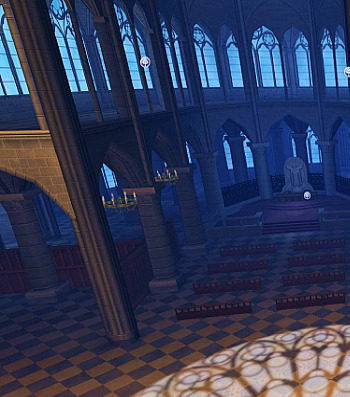
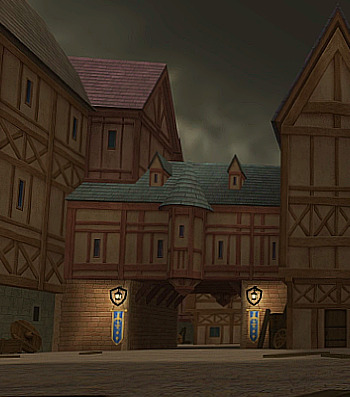



Kingdom Hearts Dream Drop Distance - La Cité des Cloches
#kingdom hearts dream drop distance#khddd#la cite des cloches#scenery#my gif#the battle music that plays here creates such a cool and grand atmosphere#i'm so used to spending most of my time in the town or at the cathedral that i forget how dark and gloomy this world can be#sora has to walk past thousands upon thousands of skeletal remains and we don't even get a single cutscene of him reacting to any of it#but i like that there are at least some big open spaces that let you go crazy with flowmotion and climb up the tall buildings and towers#and that you can actually climb up the cathedral from the town square below#but one of my favorite parts in the whole game is playing through riku's side of the story in this world#i love the themes it explores and the insight it provides for his character. so good
187 notes
·
View notes
Note
hi what a great event you've gone for! Could I request Toji from jjk as a gargoyle? I'm not too bothered if it's NSFW or SFW - whatever you feel like I guess? thanks!
Guardian Eyes: Gargoyle!Toji Fushiguro x Fem!Reader
wc: 873
tw: none
2K Follower Event Masterlist: Monster Mash
There isn't much Toji can do during the day. He's stuck to his post on the precipice of the cathedral, pretending to observe the city below while he actually sleeps (and he sleeps a lot).
But when the night draws its colors across the sky and pulls the city to bed, he awakens, shaking the ash off of his body and inhaling the smell of the darkness. Toji can't recall what it feels like to be anything other than stone - his life before must have been miserable until his creator carved him from the rock and set him upon a cathedral for all to look up at in wonder.
It's on these clear nights that he takes to the sky, using his wings to bring him as close to the moon as he can get. This is the freedom he can have, the one thing he can do for himself, the simple task that sets him apart from the other gargoyles that have gone before him.
As Toji muses upon the things that separate him from the rest of his stony crew, he spots a flickering light just below, and something he doesn't see often.
A woman running around at night.
Curiosity gets the better of him - this is a rare sight, indeed - and he perches upon a roof, watching you go about your task of running through the streets, a lamp held in your shaking hands.
On the other side of the town square, there are three men with torches also running - with you or after you? Toji can't determine which one it is, but by the looks of it, you're banging on doors for entry, shouting something indeterminable.
One of the men spots you then shouts to his companions, and you take off running, dropping the lantern and dashing through the night air.
You're running away from them.
Toji feels something kickstart his muscles and before he realizes it, he takes off, soaring above you in the light of the moon. When you make it to a dead-end, Toji swoops down, his green eyes, curved horns, and massive wings startling you so bad that you fall onto your haunches.
"P-please, sir, I have noth--"
"Come with me," he urges you, holding out a muscled arm. "I'll help you escape." You look back, hearing the sounds of the men rapidly approaching, then look back at him, taking his arm and hosting yourself up into his grasp. "Hold on."
Your screams peal through the night as you're launched into the air with Toji, holding onto his frame for dear life.
"What the hell--"
Toji focuses on the only place that will suffice for safety - a place that he'd personally be able to survey as long as he wanted to. You've stopped screaming by the time he climbs onto the top of the cathedral, but your fingers have to be pried off of his skin and returned to your sides one at a time. Wobbly-legged, you stagger around the roof as if you've been shaken violently, head spinning with thoughts that include "why" "how" and "what".
"You can thank me at any time," Toji grumbles, picking his ear lazily.
"Wh-Why did you bring me here? Wha---"
"You were obviously in trouble," Toji groans, rolling his eyes to disguise the fact that he's actually glad you're here to keep him company. "So, I helped you."
"Thaaannkks..." you begin, but as you look around the roof, you wonder if you should really be thanking him. There's no way to get down.
"I'll make sure you get down safely before dawn," Toji mutters, looking over the ledge at the sleeping city below. "But you have to promise to--"
"Like hell, I'm staying up here with a fucking gargoyle," he hears and sees you trying to climb off the ledge and down to... wherever you had decided to go. "I've heard the stories."
"Hey!" Toji dashes for the edge of the building and snatches you up, sneering while he pins you beneath him. "Don't... fucking... climb down."
"So you're holding me hostage now?"
"Hey, hey, hey, what're you kids doing up here making all this ruckus?" A gargoyle mutters, shaking off his ash and unfolding from his crouched position. He pushes back his white hair and lets his blue eyes rove over the scene in front of him before sharply turning around, shaking his head as he walks back to his post. "Toji, if you're going to do that, please don't do it up here where we can all hear you."
"It's not like that--" Toji growls, but the white-haired man grunts, taking his position on the edge of the building again and becoming stone again. Toji inhales deeply, letting your wrists go and standing up, his height towering over you.
"Stay here for the night. In the morning, you can go down to the church and claim sanctuary. Until then, I'm going to watch over you. Got it?"
"G-got it," you mumble, watching Toji stalk off to his seat on the corner of the roof, his green eyes focused on you. "So... your name is Toji?"
The look he gives you is anything but friendly.
"This is gonna be a long night."
#toji fushiguro#toji fushiguro x reader#jujutsu kaisen imagines#jujutsu kaisen#jujutsu kaisen x reader
74 notes
·
View notes
Text
An Unintentional 32,000 steps!
So the other day, I was asking a shop owner directions to the main square. A man named richard from the UK stopped me and said no no no come outside right now. Never ask the locals for directions. He has been right four times now! We actually read the map together and figured out where I needed to go. And where he needed to go to find his lost wife. Anyway, today I asked “George“ my Airbnb host, how to walk to the beaches. That was a mistake. But it ended up with good rewards. He set me on a path to? From what I could calculate from signs, it should have been 6 km. These are the beaches that are outside of town that are supposed to be so beautiful ....anyway I went about 3 km east rather than south. Fortunately, I ended up at the Temple of Dionysus. See photos. I say fortunately because ,can you believe Dionysus is the god of wine, celebration, and fun. He supposedly hid in the lush green forests and was always drunk on wine, a “drunkard god” . He fell in love with one of the Goddesses, I can’t remember her name, and she ran and hid in the forest because she did not want to marry him. But he found her and they married and he built this temple for her. The remains of the temple are just a few pillars, but it was built before the acropolis. In 550 BC. When the Christians? Or someone came and conquered them, once again they took apart the temple and built a cathedral with the marble. The only things that stand are a few pillars. And way off yonder you can see on the skyline the marble church. Nonetheless, I feel blessed to have found the God of wine and celebration.
Since I seemed to be in the wrong place, the temple guide gave me directions and off i went. Fortunately today was a very windy day ...strange the sun was hot but the wind was cool. And it was really windy so that probably helped me survive. I walked to the farthest beach away from town. And was desperately in need of water. Instead, I found the cheapest chair on the beach. I’m proud to say it was only eight euros. The downside? Or upside? it was a nude beach. I may have been the youngest person there by 10 years. So I read, and slept, and read, and slept, with all the nudies, and all of us who weren’t nudies, until I decided it really was time to get water. Cafés line the beach so that was an easy find. I also got spicy feta dip for lunch. I left Airbnb at 9 o’clock in the morning. I left the nude beach at three in the afternoon. I started walking and walking the long stretch of beaches back to town. The best part was an outcropping of rocks I had to walk over. But they were huge boulders and you could just lay in the sun and watch the waves below. So I sat there for about an hour, reading and enjoying the wind.
My Airbnb host had given me two options for travel to the teachers. By Road and one by beach. So on the way back I figured the way back beach wouldsurely work. Wrong. There was a mountain separating the beaches I was that and the beaches I needed to get to you. I was climbing over Sand dunes, walking in the hayfield, skirting the mountain and the unwalkable shoreline . but I made it back safe and sound. At 6:30 at night. Just enough time to check my email go to the grocery store get some happy hour snacks and head for sunset at the beach. Magnificent sunset. And chilly night. Can you believe it? Anyway tonight is leftovers from last night. I only spent €22 the entire day today. Pretty thrifty
Sheila have an amazing time on your cruise..Barcelona! Rome! Ahhhhh...Andy have fun in Illinois with the boys and Buffett!
Tomorrow I head to Santorini! See you there
2 notes
·
View notes
Text
Top 15 Places to Visit in Ireland
Welcome to the Emerald Isle! A property of greenery mystical ruins, rocky woods, woods that are leprechaun-dotted, bars that are shanty set into the ditties of coastlines beer pubs and folk, Ireland is just a miracle to behold. We have a good look in 15 of the spots which each traveler maneuvering into the corner of Western Europe needs to have on this menu. Kindly explore our listing of this finest places to See in Ireland:
Dublin
Raucous Dublin needs no introduction! A town of Guinness-fuelled bars that capital city, and Georgian structure continues to draw travelers from all over with its own cocktail of heritage and culture, class and hedonism.
Place mid way down the gorgeous shore of the Irish Sea, the town boasts the gigantic St Patrick’s Cathedral (the greatest of its kind in Ireland) and the acclaimed Dublin Writers Museumwhere passengers may imitate the lifestyles of Joyce, Yeats et al..
Even the Guinness Storehouse brings tasters having its ales, Temple Bar Square is famous for the delights, killer restaurants and drinking joints and whilst whiskey distilleries are not much off.
Cliffs of Moher
Probably one of the most visited attractions like bulwarks of rock in all Ireland, the Cliffs of Moher rise up from the swells of the great Atlantic Ocean. Along with they have been coated using the signature meadows of green bud of the island, as Galway Bay’s waters wreck along with froth contrary to the rock below.
In a whopping 120 meters in elevation, these fantastic cliffs provide stunning views of the shore and the Aran Islands outside at sea, even while still an allnew visitors’ centre makes it simple for visitors to find the countless hundreds of millions of years of geological history which helped shape the stratas of sandstone and shale.
Ring of Kerry
In case in Kerry, simply just take the opportunity to research what’s arguably Ireland’s most scenic road, ” the Ring of Kerry (Iveragh Peninsula). Needless to say you’ll be able to begin anywhere on the road, nevertheless many place from either Kenmare or even Killarney end, naturally , back at precisely exactly the exact same spot.
That is not likely to occur, although the journey nonstop may simply take under 3 weeks. En route there exists a feast of Atlantic Ocean views islands to see mountains that are sweeping, and scenic villages.
This region of beauty has a range of outdoor pursuits including cycling, watersports on beaches, golf, walking, horseriding, and freshwater fishing along with deep angling. For background lovers, there are placed against a picture of landscapes that were striking.
The Rock of Cashel
Ireland’s most visited heritage site, the Rock of Cashel, stars in countless images of the Emerald Isle. Queen Elizabeth II of Great Britain even visited by helicopter during her 2011 official tour of the country. Perched upon a limestone rock formation in the Golden Vale, this magnificent group of Medieval buildings includes the High Cross and Romanesque Chapel, the 12th-century round tower, a 15th-century castle, and a 13th-century Gothic cathedral.
The restored Hall of the Vicars Choral is also among the structures. Tourist attractions include an audio-visual show and exhibitions. It’s also said that this was once the seat of the High Kings of Munster prior to the Norman invasions.
Sligo
As the town of Sligo packs a punch with wealth of pretty town houses, arched stone bridges abbey plus its ancient center, it is the back country. Imbued with the love you’d expect of this place which helped form the mythical West Yeats, this part of outstanding all-natural beauty climbs to peaks with all an powerful monolith of Knocknarea Mountain (the mythical resting place of Queen Maedbh), comes teeming with moss-clad, centuries-old cairn stone and leaves for some truly breath taking views across the pebble shores and salt-sprayed towns of Sligo Bay.
Killarney National Park
Nestled beneath County Kerry’s other temples, the untouched and crazy reaches the Killarney National Park are worth a reference in their own right. Attested trodden and from UNESCO by herds of red deer that is royal, this location hosts swathes of walnut, ash and yew woods.
All these come together together with the Lakes of Killarney, which sit mirror like beneath their Purple Mountains’ shirts. The region is a mecca for wild life fans and sailors, who are able to discriminate between more woods and bogs at the business of both kingfishers swifts and ospreys.
Boyne Valley
Stretching out of County Kildare into the Sea’s heartlands, the Boyne Valley Is Currently the answer of All Belgium to This Loire of France or Even Meuse of Ireland.
Green and beautiful into the hilt, this property lives around this Emerald Isle’s moniker. Between its own boundaries, travelers may observe wonders for example the Newgrange monument (that’s thought to date back over five millennia) and the walls and gatehouses of Trim Castle — once the strong hold of Norman rule in Meath.
Together using oodles of paths weaving its riparian banks round Readily accessible from the administrative centre in Dublin the valley creates a nice escape from town.
Dingle
Its eponymous peninsula’s administrative centre swells, Dingle sits between shore and the shores of County Kerry as well as the ridges of this pilgrimage area of Mount Brandon. Steeped in charm, bobbing fishing ships besets town and includes a salt-washed sea-faring personality.
Whilst whiskey from the distillery appears to be that the tipple of choice, irish is the speech of performance too.
Besides wallowing from the backwater vibe , match between the boutiques and pubs around Quay Street, go dolphin viewing, and travelers may choose to explore the panoramas provided by this Conor Pass.
Galway City
Crowned by the Gothicism of St Nicholas’ Church, Galway City Flourished . Sights like Lynch’s Castle belie the history of this town’s retailer mayors using this age of time, whilst the actual nature of Galway lies within its own boho, unique facet, which bubbles upwards across the town’s roads together with actors and magicians on the weekend, even pops out from the cafes to the Promenade of Salthill, becomes excruciating throughout the town’s art festival in July, and that so it’s not far from your bars of Cross Street and the guts.
Blarney Castle
For ever drawing outside of Cork’s guts, this collection of battlements and keeps is top among the set of the bucket list sights of Ireland. Some regions of your website have been rebuilt, as the Blarney House stands tall over the face of the castle, Now, and nature walks. The piece de resistance?
Well, which must be the Blarney Stone, which is supposed to imbue some that kiss it with all the gift of their gab that is Irish!
Cork
Cork remains the 2nd biggest city of Ireland. Since it makes its way towards the branches of this Celtic 33, it is seen perched from the coastlines of its county, cut by the twisting River Lee.
Divergent to Dublin, fun-loving, a bit laidback and lively, the natives here enjoy distance between the interested coffee shops and bars, most which hide spouting the colonies of St Patrick’s from of their town.
Even the spires of the Cathedral of St Fin Barre over look that the town in Gothicism, as the Cork City Gaol can be just actually really a quality appeal in the outskirts — even when your little gruesome on top of that!
Glendalough
Nestled between County Wicklow to the eastside of Ireland’s mountains, Glendalough’s valley brings people . The Saint Kevin of Glendalough dates from sometime in the 6th century, which set the abbey at the centre of this site, also showcases several of those medieval structure in the nation.
Where warblers flit involving the Conservancy and the trails pierce all around this cloister, travelers may look to a woodland of pine and fern, hazel and mountain ash.
The Aran Islands
Brought in 1934 to world attention by the documentary Man of Aran, traffic have now been entrancing since. Since it was, this is actually really just a preference of Ireland. Gaelic is the primary language, a inhabitants really certainly are, and once you will feel as though you are at a timewarp.
The islands, wild, wind swept, rocky, and completely exceptional provide you a tourist experience. The stone fort of Dun Aonghasa and the cliffs of Aran will not be forgotten, once experienced. The culture is different from the mainland, the tradition can’t be found else where and also the scenery is breath taking.
County Kerry
Famous because the Ring of Kerry drive’s house, this county of this Republic is you to write home about.
Between its own boundaries, this property in the heart of Munster hosts the kind of this towering, 1,000-meter-high Macgillycuddy’s Reeks and the church-dotted, cairn-peppered puzzle of this Slieve Mish, while outside at sea increase the rugged daggers of this Skelligs — even Michael using its own UNESCO monasteries and Small Skellig having its craggy outcrops.
Even the mountain lakes are just another highlight oceans which flanked by peaks from Torc and Mangerton and can come surrounded by farm lands that are rocky in Muckross.
Limerick
Spread on the banks of the River Shannon since it widens to fulfill with up with the Atlantic on the western haunch of Ireland, travelers in preference of their attractions which have made Munster’s spot famous usually overlook the town of Limerick.
But will detect a town that on the re-invigorated after bankruptcy, upward and prepared to exhibit its Guinness bars and passionate love for the game of rugby.
Moreover, the area continues to be wallowing at the prestige of being Ireland’s National City of Culture, together with areas just such as the Belltable Arts Centre exploding with fresh productions and playsthe University of Limerick echoing with plain chant and the metropolis gallery of hosting events just such as the EVA International festival.
Top 15 Places to Visit in Ireland
1 note
·
View note
Text
Portugal Day One: Porto
After yet another mad dash to the airport (I never learn do I?) and running back and forth to the check in desks I actually made it to the gate with time to spare. On board the crew were sassy and tried to tell me to store my bag under the seat, at the same time I was being told by another passenger in my seat that I needed to take his seat further back while all the people behind me were hounding me to try and get past. I don't know where I got this bad airplane karma from as I'm always patient and when I have a small bag I store it under the seat. But I refused to take a three hour flight with my huge blue bag taking all of my leg room this time! Not when I'm watching people "carry on" about five bags each and then store all of them and their jacket in the overhead compartment. We flew beneath the clouds over Porto right on sunrise so from my window seat I could see lots of small townships and jagged hills below. Upon arrival I was handed a map of the city, then sneakily bought the cheapest train ticket I could (only for one zone rather than the 3-4 I needed to travel) and rode all the way to the metro station 24 de Agosto. It was very busy on board as it was the morning rush hour so I think I was safe with my single zone ticket although I didn't see any ticket inspectors the entire 40 minute ride anyway! As you may have guessed my first destination was a specialty coffee shop of course - Mesa 325. A Google search hadn't turned up very many results for specialty coffee in Porto and this one was the only one open before 9am. Inside there were only two other patrons and the barista working at a desk on his laptop. He invited me to sit down and gave me the menu which was extra hipster as it was contained in a small photo album. I took a flat white and a jam croissant and enjoyed them slowly as I planned my route for the day on my map, circling places of interest and researching prices for winery tours and tastings. I sat in the cafe for a little more than an hour which is not something I would usually do but it was so peaceful and quiet and I didn't feel pressured to leave like I sometimes do. It was quite chilly outside as I set off walking to my hostel, just down the road near the Bolhão metro station there was a magnificent church covered in blue and white tiles - definitely not the last one that I'd see! I passed a wide entrance with open gates and thought I should poke my head in for a look and lucky I did as I discovered the Mercado do Bolhão market downstairs! I bought a few small souvenirs and carried on to the hostel browsing in a few more kind of unique looking knick knack shops along the way. I had already concluded that Porto had the feeling of a small comfortable town full of local people, yet it is a huge city with a population of 2.4 million within the urban area, of course it is the second largest city in Portugal. I stored my bag at my home for the next two nights, the Pilot hostel, and then started my adventure! I began with a walk to the famous Livraria Lello bookshop but the huge queue outside made me immediately move on with promises to return later in the day. I passed the São Bento train station which had been tipped to have a beautiful interior so I ducked inside like many others just for a glimpse of the ceilings and a few photos. On my walk to Gaia I passed the cathedral but there was a large tour group outside and the sun was high in the sky behind just to ruin all my photos with overexposure. I was feeling a little peckish and passed by some food trucks selling tasty burgers which I stupidly ignored. I crossed the Ponte Luis bridge on the top tier which has access for pedestrians and the tram only so it was very peaceful and easy to cross from one side to the other and back again to take all of my photos over both sides of the spectacular views of Porto. On the other side of the river is where all the port wineries are located and there isn't much else. I walked down the boardwalk all the way to the end in search of food but only found pricey (and empty) restaurants and a suspiciously deserted looking supermarket which turned out to be a wholesale market. Without the willingness to be dragged into a restaurant by a pushy host and have my pockets emptied I settled for some churros as a snack. They were a bit cold and covered my jacket and shoes in cinnamon sugar dust but the girl had given me 8 for the price of 6 so it wasn't all bad! Since I was in the neighborhood I decided that I'd do the port winery tasting tour now too and I'd already mentally picked out Cálem as the one I'd visit. It was quiet and informative and the guide Joanne was very knowledgeable. The museum part before the cellar tour was very interesting with videos about the harvest process and information about the different varieties of grapes and fermentation processes to make the different varieties of port. The oldest bottle in the winery was from 1871 and they have only 8 left in their collection, it sat covered in grime in a display case with some other old vintage bottles of port. Of the people on the tour 8 out of 10 were from China and I'm confident that only 2 or 3 had any idea what she was saying and would translate for the rest later. We were able to see the process of making the vats and then saw how big they were when we entered the cellar. We learned about how the conditions are perfect in the Doure valley for growing the grapes and the conditions in Porto are perfect for fermentation and storage of the port. The young ports are very sweet and the older ones are dryer because the sugar is converted to alcohol and dries with age. Port is made under controlled fermentation processes so once the desired flavour is achieved the fermentation process is stopped and the port can be bottled. Joanne told us about how they'd clean the vats by climbing in with a candle for light which was extremely dangerous of course with the alcohol fumes so the cleaner would sing and if he stopped singing it meant that he'd passed out inside the vat and his colleague would need to come and rescue him. We moved along to the final treat, our chance to taste the wines at last! Each of us had a white and a red in front of us to try. We were invited to smell, swirl and taste while Joanne explained the particular bottles we were sampling, a 3 year old white dry and a 7 year old tawny. Much to my surprise, as I'm really not a fan of wine at all, I quite liked them both. I thought I'd hate the white and maybe be able to tolerate the tawny but in fact they were both good, although I think I'd rather enjoy them as cocktails like Joanne said they commonly become! I took some photos in the gift shop then left to find it was still light outside and actually it was warmer and sunnier than when I'd gone in! So my opportunity was there to get nice photos for Instagram and the blog! On my way back to the hostel I very luckily passed the 22 tram that so defines Portugal, and I saw that I was right by the bookshop again so I went over to check it once more to see if the line had disappeared. It had but now I could see the sign that said it would be a €4 entrance fee and then you get this discount on books! A fee to enter a shop! Well now I've seen it all! I was checked in to my room by José and took my trusty top bunk again with just enough time to unpack before my Spanish roommate came in and obnoxiously had a phone conversation on speakerphone. I chilled for a bit then went out in search of a bank, and also stumbled upon the giant Christmas tree in front of the Igreja da Santíssima Trindade city hall which was stunning and my poor quality evening photos couldn't do it justice! Further down there were a bunch of swings with Portuguese words written in neon lights on the top like "Natal" "Familia" it was very cute and Christmassy. At the bottom of the square were the blue letters spelling out Porto and the Intercontinental hotel all done up like a Christmas tree with the best view in the house. I managed to find a bank and withdraw some cash to treat myself to Steak N Shake for dinner - lured in by the cool mosaic mural on the side of the building. I opted for the western BBQ bacon burger, fries and a chocolate milkshake as I hadn't eaten much all day! I was lying in bed quietly ready to sleep and suddenly in bursts another new roommate who has apparently never heard of headphones yet loves to watch videos on his phone for hours...
2 notes
·
View notes
Photo

Original content owned & copyrighted by Green Global Travel.
Located off the coast of Teide National Park in the center. In the north, you’ll find the capital, Santa Cruz. The island’s south side is more popular with travelers because it’s both sunnier and warmer, with quite a few RED MORE: The 30 Best Exotic Islands to Visit
is Tenerife?
to Get to Tenerife
Brief History of Tenerife
Best Things to Do in North Tenerife
Best Things to Do in South Tenerife
Tenerife Mountains image by Monique Stokman from Pixabay
is Tenerife?
The volcanic Canary Islands are located in the North tlantic Ocean off the coast of frica. But where exactly is Tenerife?
The Spanish-owned archipelago is located around 60 miles west of Morocco, and Tenerife sits right in the center of the group of seven islands.
You’ll find Tenerife just west of Gran Canaria, which is the third largest island in the Canaries at 600 square miles. bit further to the east lies Fuerteventura, the second largest island at 640 square miles.
Flights from the RED MORE: 10 Eco-Friendly European Islands (World Travel Bucket List)
Image by Hans Braxmeier from Pixabay
to Get to Tenerife
Tenerife is the only Canary Island blessed with two airports, making air travel the easiest and fastest way to get there.
Most international visitors come via flights to Tenerife south, which is serviced by Reina Sofía. This is the more modern of the island’s two airports, located just outside of Costa deje.
Flights to Tenerife north land at Los Rodeos irport, which is located near La Laguna and Santa Cruz. This airport primarily receives traffic from mainland RED MORE: The 20 Best Caribbean Islands to Visit
Brief History of Tenerife
You can date Tenerife’s recorded history back to around 200 BC. t this time the Canary Islands were home to aboriginal inhabitants, known as the Guanches. who were of North frican origin.
They were said to have an almost King Juan Carlos I took the Spanish throne. He and his wife, Queen Sofia, reigned as King and Queen of Spain from 1975 until the king’s abdication in 2014.
Southern Tenerife’s airport is still named after Queen Sofia. nd today, tourism is back in full swing and stands as the island’s largest and most profitable industry.
RED MORE: Things to Do in Portugal for Nature Lovers
Things to Do in Northern Tenerife
Loro Parque Parrot, image by marbus79 from Pixabay
1. Loro Parque
Widely recognized as one of the finest Loro Parque began as something of a giant aviary for exotic Parrots. It has since been expanded to house rare and merican Humane has given Loro Parque its seal of approval for its commitment to animal safety and well-being. It’s the first time the 100-year-old NGO has ever given approval for a standard zoo in Europe.
The zoo is also a member of the International Union for the Conservation of Nature. Loro Parque has been involved with over 80 conservation projects, contributing more than $10 million towards wildlife conservation.
RED MORE: The Best Environmental & nimal Charities to Donate To
Mount Teide image by Jordi Martos from Pixabay
2. Teide National Park
Teide National Park is one of Tenerife’s two UNESCO World Heritage Sites, so it’s no surprise that it’s one of the island’s most visited natural wonders. The park is home to Spain’s tallest peak, Mount Teide, an RED MORE: 20 Tallest Mountains in the World
San Cristóbal de La Laguna image by nina056 from Pixabay
3. San Cristóbal de La Laguna
Tenerife’s second UNESCO World Heritage Site is the historical center of San Cristóbal de La Laguna. Considered to be the island’s cultural capital, it was at one time the actual capital before that role was taken over by Santa Cruz.
La Laguna was founded in the 15th century and is home to many important early buildings, including several beautiful churches.
One example is the Roman Catholic Cathedral of La Laguna, which houses the remains of the city’s founder, lonso Fernandez de Luga. La Laguna also plays host to the largest Holy Week festival in the Canary Islands.
The city is home to the Canary Islands’ oldest university, University of La Laguna, which was founded in the early 1700s. Due to the presence of college students, there’s a great deal of energetic nightlife options available in the city.
RED MORE: The 20 Best Festivals in the World
Museum of Nature and Man image by neufal54 from Pixabay
4. The Museum of Nature and Man
Paying a visit to the Museum of Nature and Man in Santa Cruz allows you to dive deeper into the history of Tenerife and the other Canary Islands.
Housed in the Old Civil Hospital, the RED MORE: 10 ncient rchaeological Sites (World Travel Bucket List)
Image by Noelia Secret from Pixabay
5. Jardín Botánico of Puerto de la Cruz
lso known as the La Orotava cclimatisation Gardens, the botanical garden (or Jardín Botánico) of Puerto de la Cruz was conceived by King Charles III of Spain.
It was his desire to introduce exotic plants from regions like RED MORE: What is Permaculture Gardening? n Intro to Permaculture Design
Pyramids of Guimar, Tenerife image by M W from Pixabay
6. The Pyramids of Guimar
series of six pyramids on Tenerife have created a lot of debate over the years as to when they were constructed, and by whom. Built from lava stone, they share a resemblance to the pyramids found in RED MORE: The 16 Best Mayan Ruins to Explore
Trail image by Hans Braxmeier from Pixabay
7. Bosque de Esperanza
One of the island’s largest forested areas, Bosque de Esperanza offers wonderful hiking and mountain biking opportunities.
There are also narrow mountain roads that lack the copious traffic often found in southern Tenerife.
The hiking trails are well marked, and some will take you to viewpoints where you can enjoy stunning views of Mount Teide, the coastline, and La Laguna below.
The forest itself offers a robust mixture of endemic pines, cypress, and eucalyptus trees, which stay lusg and green all year round.
RED MORE: 20 Biggest Forests in the World
Masca Trail, by Hans Braxmeier from Pixabay
8. Masca Valley
The Masca Valley is home to another one of Tenerife’s most notable hikes.
The Masca Trail hike, from Masca Village to the sea, takes around three hours to complete. It leads you through a volcanic landscape of strange rock formations and caves.
When you reach the end of the trail you can return the way you came. But many hikers choose to catch a boat transfer to the nearby resort town of Los Gigantes. The town is known for its towering cliffs, which reach heights of atound 2,800 feet.
If you choose this option and you’re traveling during peak summer season, make sure to pre-book your boat transfer. This assures your spot, so you aren’t forced to hike all the way back to Masca Village!
RED MORE: The World’s Best Hiking Trails (World Travel Bucket List)
Cueva del Viento or Cave of the Wind by Eladio nxo Fernández Manso via CC-2.0
9. Cueva del Viento
Cueva del Viento (or Cave of the Wind) is Europe’s most grand lava tube system. It’s also one of the world’s most complex.
Reaching over 10 miles into the earth, the cave system is said to have been created from Pico Viejo volcanic eruptions. Visitors outfitted with sturdy RED MORE: 10 Famous Underground Caves (World Travel Bucket List)
Best Things to Do in Southern Tenerife
Siam Park in Southern Tenerife by stephen jones via CC BY 2.0
10. Siam Park
Located in the Southern Tenerife town of Costa deje, Siam Park is one of Europe’s grandest water parks.
The water park is home to the world’s longest lazy RED MORE: The 13 Most Beautiful National Parks in Thailand
Playa de las méricas by Brian Mullender via CC 2.0
11. Playa de las méricas
Southern Tenerife’s largest tourist resort, Playa de las méricas is where all the area’s action and nightlife can be found.
Head to Veronica’s Strip for a wide array of nightclubs and bars, or soak up the sun at one of the area’s numerous beaches.
Some of the beaches are natural, featuring the iconic black volcanic sand Tenerife is known for, while others are man made and use sand imported from frica. The most notable beaches include Playa de El Bobo, Playa Honda, and of course Playa de las méricas.
lso on offer are water activities like jet-skiing, RED MORE: The Ultimate Beach Vacation Packing List
Playa del Duque User: Mulleflupp at wikivoyage shared via CC BY-S 3.0
12. Playa del Duque
Located in Costa deje, Playa del Duque is a man made beach that offers imported golden Sahara sand.
Its westward facing position makes this a perfect location to catch a Canary Island sunset. The seaside promenade makes for lovely early morning or evening walks.
During the day, plenty of sun loungers and umbrellas are available to rent. Just off the beach you’ll find an array of fine dining restaurants and a luxury shopping center.
Playa del Duque is easily one of Tenerife’s most beautiful and most visited beaches, but be aware that it can get crowded during peak season.
RED MORE: The 50 Best Travel Shoes
Kite Surfing in Southern Tenerife, image by Erdmann-Crew from Pixabay
13. El Medáno
Home to less touristy beaches, the town of El Medáno ranks alongside places like kitesurfing championships.
Near the center of the town, you’ll find beaches that are a little more suitable for swimming. Some of Tenerife’s largest natural beaches, including Playa Grande and Playa La Tejita, are also farily close by.
More popular with locals rather than tourists, Playa Grande is best visited during low tide.
RED MORE: The Beautiful Beaches of Coron, Palawan
14. Reserva mbiental
One of the top-rated natural attractions in southern Tenerife, this quiet little nature reserve is located in San Miguel de bona.
The morning guided hikes are best booked in advance, and take you on a one-hour journey through a pristine slice of Tenerife as it might have looked before the Spanish arrived. The boat ride across the small lake is as tranquil and serene as it is picturesque.
Departing from the Sandos San Blas Hotel, the tour also includes an excellent museum with an overview of the island’s past, including a cool “time tunnel.” long the way you’ll meet costumed actors who bring the RED MORE: 10 Living History Museums in the US
Southern Grey Shrike Per-nders Olsson (used with permission) via CC BY-S 3.0
15. Montaña de Ifara y Los Riscos
Those really looking to get off the beaten path and escape the tourist crowds can try a bit of hiking in the Ifara and Los Riscos
Megan Jerrard is an ustralian Journalist and the founder and Senior Editor of Mapping Megan, an award-winning travel blog bringing you the latest in adventure travel from all over the globe. Her husband Mike is the merican naturalist and wildlife photographer behind Waking Up Wild, a website dedicated to opening your eyes to the wild & natural world.
The post 15 Things to Do in Tenerife (Canary Islands) appeared first on Green Global Travel.
#><strong>Morocco</strong></span></a>#008000;#>beautiful#Where#How#A#Top#>Spain</span></strong></a>#><strong>London</strong></span></a>#><strong>Rome</strong></span></a>)#><strong>Scandinavian</strong></span></a>#><strong>Caribbean</strong></span></a>#><strong>zoos</strong></span></a>#><strong>Australia</strong></span></a>#><strong>Gorillas</strong></span></a>#><strong>Galapagos#><strong>national
0 notes
Text
Tallinn, Estonia
The last weekend of our program we went north to Tallinn, Estonia and I made sure to go a little overboard with photography. Please enjoy the last status update from the 2019 Georgia Tech Russian Spring Track and LBAT crew! (Photo captions are below the pictures this time around!)
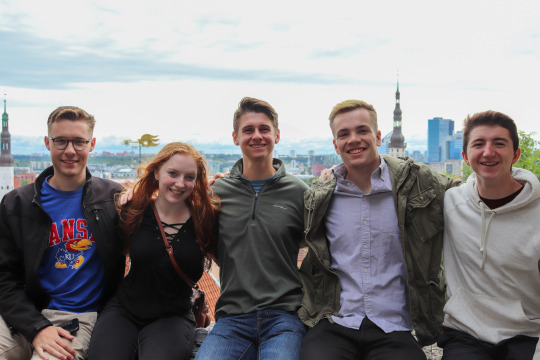
Here is all of us (except me of course. Such is the life of the photographer) with the Tallinn skyline in the background. Tallinn’s Old Town, like Vilnius’ and unlike Riga’s is surprisingly hilly. This is us at the top of the hill. From left-to-right Mason, Julia, Joey, Kenny, and Will.)
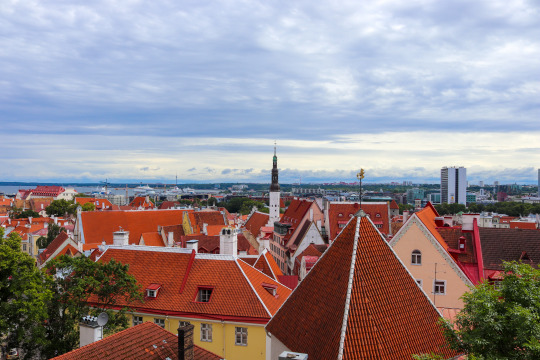
A clearer picture of the skyline. The red/orangish rooves of Tallinn’s old town looked great.
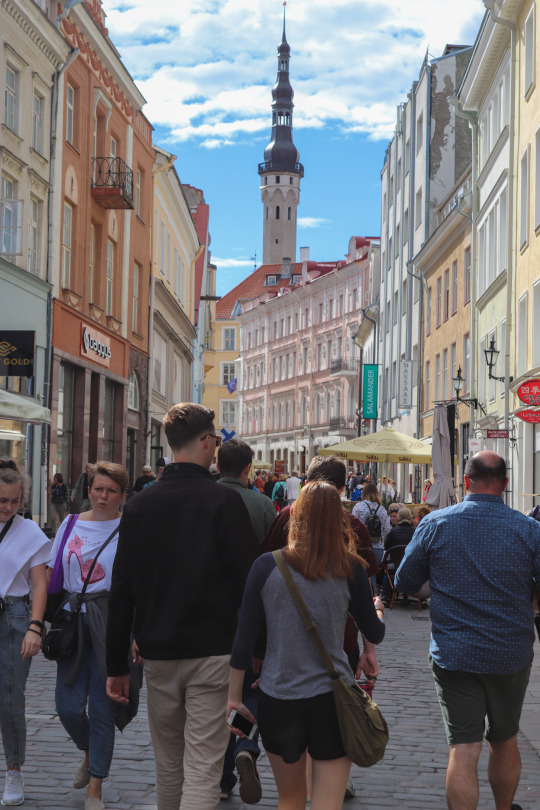
After climbing to the top of Tallinn’s Old Town’s hill, we met up with Rachel who made a 5-hour trip west from St. Petersburg to meet up with us in Tallinn. Here we are just beyond Old Town’s gate. Tallinn’s Old Town, compared to others has far more medieval architecture and notably less Romantic (Riga), Baroque (Vilnius) Rennisanse (Krakow).

Here is Rachel and Will under a uhm, a little creepy statue. This is actually one of three statues called “The Faceless Monks” that sit in the Danish King Garden

Here is Alexander Nevsky Cathedral. Compared to other similarly ornate Orthodox Cathedrals in Europe, this one is fairly new dating back to around 1900. Still, it’s incredibly grand and was meticulously restored after the fall of the Soviet Union.

Joey pointing to his new best friend. The seagulls in Tallinn frequently pose on the side of stone walls overlooking Tallinn begging for treats in exchange for photos. Birds be smart, yo.

Here’s Mason enjoying some pretty incredible shawarma while Will looks on jealously. Tallinn had some great cuisine and this (slightly-hipster) part of the city instantly made us feel like we were back in Atlanta.
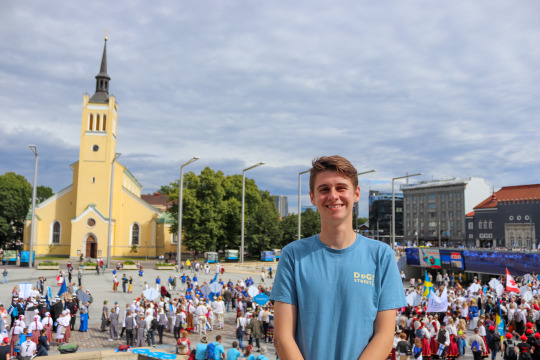
Another picture of Joey but here you can see people with ties to Estonia who have traveled from across the world organizing under different flags in Freedom Square. Many of these folks marched in the day’s parade and attended the Estonian Song Festival.
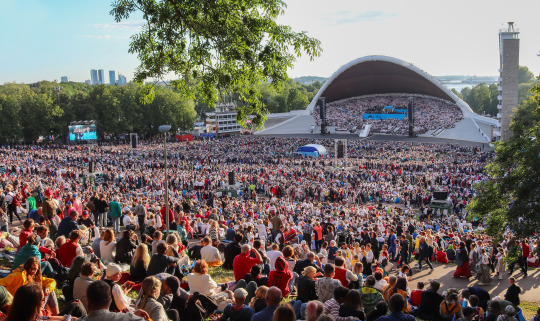

The Estonian Song Festival, or laulupidu, is held once every 5 years. Estonian citizens travel from across the country (and indeed the world) travel to the grounds to sing songs and celebrate Estonia. The event is tied directly into the Estonian national awakening and the independence of Estonia dating back to 1869 where around 800 Estonians participated. Now, it’s over well over 100,000.
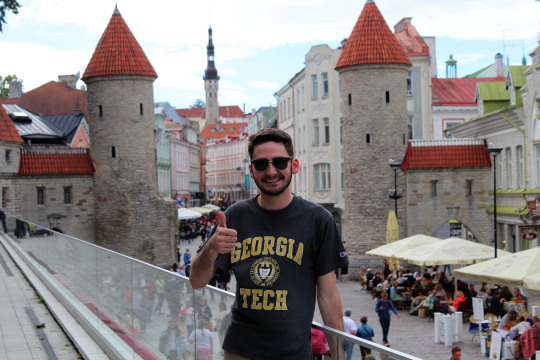
That should be it! Shortly after our trip, most everyone flew home to relax and prepare for a new fall semester at Georgia Tech. Not me though! I’ll be here for a while, and back at Tech after I finish my Boren here in Tallinn. If something super cool happens while I’m abroad this year, I’ll be sure to see if I can share it. My adventures abroad have only just begun!
#PUBP#Public Policy#GT#GTLiberalArts#Georgia Tech#Study Abroad#Russian LBAT#LBAT#Tallin#Estonia#student
0 notes
Photo
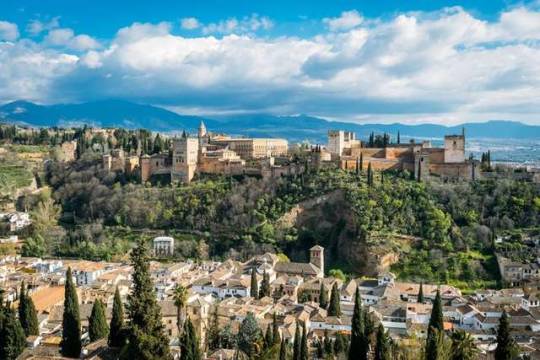
Best Things To Do in Granada, Spain
Granada, Spain
Granada is a beautiful little city in the South of Spain where I lived for a month as a digital nomad. Here are some of the best things to do in Granada if you’re passing through!
Located at the base of the snowy Sierra Madre mountains, the city of Granada is full of history and character.
Because it was once a Muslim kingdom, much of the city has been built in a style of Islamic architecture that remains today. Granda is the ancient capital of Andalusia, a large autonomous region in Southern Spain.
Boasting a vibrant population of university students, free appetizers with your wine, skiing in the mountains, and Mediterranean beaches only an hour away, Granada is the perfect town to spend a few days while traveling in Spain.
Because I had such a great time during my visit, I wanted to share some of the top things to do in Granada with the rest of you!
Granada Spain Highlights Map
How To Use This Map
Above you’ll find a map of highlights in Granada. Click on the top left of the map to find separate layers marking the route and points of interest. You can hide and show different layers, or click icons on the map to see the names of places I mention in this travel guide. “Star” the map to save it to your own Google Maps, or open the map in a new window for a larger version. Enjoy!
Best Things To Do In Granada 2019
The Magnificent Alhambra Palace!
Stunning Architecture at Alhambra
1. The Alhambra Palace
One of Spain’s most popular tourist attractions, Alhambra Palace sits on top of a hill surrounded by forest while overlooking the city below. It was built by Moorish king Mohammed ben Al-Ahmar in the 11th century when the area was ruled by Muslims from North Africa.
Filled with Arabic inscriptions, painted tiles, vaulted ceilings, and plentiful water fountains, the building is incredibly beautiful inside and out. It was definitely a highlight of my trip to Granada, and the reason most people make the trip.
You need to buy a ticket in advance due to a strict limit of daily visitors.
Booking Tickets For Alhambra
The cheapest tickets are from the Official Website for about €14 EURO
Or skip the line with fully guided tours of Alhambra & the Gardens.
Modern Sacromonte Cave Neighborhood
2. Sacromonte Neighboorhood
On the outskirts of Granada there’s a Roma (gypsy) neighborhood build into the side of a hill, where the inhabitants live in caves. Most of the cave-homes are pretty modern these days, but in the past, this is where the workers who built the Alhambra Palace lived.
If you keep climbing to the very top of the hill, you’ll find an odd community of hippies and immigrants squatting in more rugged caves. Just be aware that they aren’t always happy to see tourists gawking at them or their homes, and some can become aggressive.
Sacromonte Cave Museum
3. The Cave Museum
Visit the Sacromonte Cave Museum (Museo Cuevas del Sacromonte) to see what life was like in Sacromonte 100 years ago.
The museum is a short climb up from the main neighboorhood of Sacromonte. I really found this place fascinating, as it features about ten cave dwellings that give you an idea of how people lived in them historically.
The Arab Quarter in Granada
4. Explore The Albayzín
The Albayzín is the historical Arab quarter of the city and a UNESCO World Heritage Site. This part of Granada has a lot of Moorish history, and this had a natural impact on the area’s architecture and decor.
For example, many of the walls are covered with gorgeous tiles that were hand-painted by the Moorish population.
Walking the Carrera de Darro
5. Carrera Del Darro
Under the Albayzín neighborhood, the River Darro flows through Granada where the old walls used to be. There’s a nice walking path that follows the river’s edge.
Enjoy the mix of renaissance and Moorish architecture, listen to street-buskers play their guitars, and try to imagine what it was like way back when.
Fuente de Aceituno
6. Drink From The Fountain Of Youth
One fun little fact about Granada is that all the fuentes (fountains) in the city provide free drinking water to anyone who wants it. Probably the most famous fountain in Granada is the Fuente de Aceituno (Fountain Of Youth).
Local legends tell the story of an olive tree growing here that started producing water, which people drank and it made them younger! I took a drink, so maybe I’ll live forever now… :p
Free Tapas with Drinks!
7. Free Tapas & Spanish Wine
You can’t visit Granada Spain without going to a restaurant or bar for free tapas! During the afternoon or evening, typically between 1pm and 4pm or between 9pm and midnight, order a beer or wine and get free appetizers!
The best streets in Granada to find great tapas are Calle Navas and Calle Elvira.
A popular snack is Black Iberian Ham, also known as jamón ibérico, a common sight at these bars. The meat is cured with salt for up to 3 years, so it doesn’t need refrigeration.
Mirador San Nicolas Crowd
8. Mirador San Nicolas
One of the top highlights in Granada is this popular viewpoint above the Albayzín neighborhood. It’s quite a hike from the center of town, but views of the Alhambra with the Sierra Nevada mountains are awesome.
Sunsets up here can get very crowded during high season, and it can be full of street performers and vendors. For an even better 360 degrees view, you can climb the bell tower of the Church of San Nicolas for €2 EURO.
This is the perfect place to get your Granada Spain postcard photo — as seen in the lead image of this blog post.
Secret Flamenco Bar in Granada
9. Watch A Flamenco Show
Flamenco is a form of festive gypsy (Gitano) folk music that originated in Southern Spain. It’s possible to visit one of the popular cave tablaos in Sacromonte that feature full flamenco dance performances.
Cuevas los Tarantos is one of the most popular spots to watch Zambra, the regional style from Granada, and shows cost about €20 EURO.
There’s also a slightly hidden/secret local cave bar which hosts incredibly authentic performances after 1am when most tourists are back sleeping in their hotels.
I’m not going to name it, you’ll just have to meet some locals to learn what it’s called! I can’t hand you ALL the best travel secrets without doing a little work…
The Beautiful Generalife Gardens
10. Generalife Gardens
The Generalife Gardens are located on a hill next to the Alhambra, easily accessible after your visit to the Palace. You can buy a combo ticket for both Alhambra & the Gardens, or just visit the gardens on their own.
The gardens are full of flowers, trees, shrubs, reflective pools, and fountains. It can be a very peaceful place if you’re there early or late in the day. You can also visit at night!
Street Musicians in Granada
11. People Watching At Plaza Nueva
Plaza Nueva (New Square) is actually the oldest part of the city. This is where a bunch of Granada’s old buildings and monuments are located.
The square used to be the site of tournaments, games and bullfights in the city. From here you can start the climb up to Alhambra Palace, or just hang out at a local cafe and watch the tourists and street performers milling about.
It’s where most people begin walking up the river Darro, along the Carrera Del Darro, to reach The Albayzín and Sacromonte neighborhoods. You can also enter the Church Of Santa Ana for free.
12. Shopping At Alcaiceria
If you’re looking for a unique souvenir in Granada, the best place to go is Alcaiceria. In the past, this area was a Great Bazaar. Although those days are long gone, you can still find earthenware that is reminiscent of the Moorish style of the Middle Ages.
I also enjoyed taking in the artistry of authentic Granada Taracea. Some of this furniture and the other wood touches would have made a nice addition to my place if I wasn’t living out of a backpack at the time!
Skiing the Sierra Nevada in Spain
13. Sierra Nevada Mountains
These mountains are technically 30 minutes outside of Granada, but it’s a must-see for all travelers. The Sierra Nevada can be accessed via car, bus or taxi, meaning there’s no excuse not to check them out!
If you’re into skiing, this is by far the best spot in Spain. If you’re visiting in the summer there’s also mountain biking, hiking and music festivals. Make sure to check out the hanging suspension bridges of Los Cahorros!
14. Parque de las Ciencias (Science Park)
Granada is a wonderful place to learn about history and view ancient architecture. To take a break from Granada’s charming evidence of the past, check out the very modern Science Park.
Unlike many science museums, this interactive location was truly built with people of all ages in mind. I was able to participate in many hands-on activities, which were also popular with children. My favorite part of the Science Park was the planetarium.
Orange Trees Everywhere in Granada!
15. Soak In A Hammam
A hammam, if you are unaware, is a kind of steam room where people go to wash themselves (or be washed by others). Visiting an Arab hammam is a very typical thing to do in Granada.
Often, they involve bathing pools, washing down with black soap, and exfoliation of the skin. The most popular hammam in Granada is Hammam Al Andalus, located in the old city of Granada.
16. Corral del Carbón
Corral del Carbón is an interesting place to visit if you’re interested in the history of the Nasrid dynasty because it’s the oldest remaining building in Granada from that era. Plus it’s free!
Built in the fourteenth century by Yusuf the First — it was used as a warehouse for goods and a shelter for merchants. Later it was also used for stage performances.
As an added bonus, if you visit Corral del Carbón in the summer there’s a chance of running into a flamenco or play performance in the courtyard. There’s also a bookstore inside the building.
The Beautiful Cathedral in Granada
17. The Granada Cathedral
Regardless of your cultural or religious views, you simply have to make some time to visit the Granada Cathedral. This stunning example of architecture was one of my favorite parts of the city.
The combination of Gothic and Renaissance style makes it pretty cool. Make sure you have plenty of room on your memory card for photographing the stunning exterior of this 16th-century masterpiece.
18. Royal Chapel Tombs & Crypt
The tombs of the Royal Chapel, known locally as Los Reyes Catolicos, were fascinating. The Royal Chapel itself is more than worth a visit if you like history.
It’s interesting to see the graves of royalty. The chapel once held the bodies of Queen Isabella I of Castile and Ferdinand II of Aragon, but were later moved. Now only the Catholic Monarchs and their children are buried here.
The entrance to the Royal Chapel is at La Lonja, in the Cathedral Complex, and it is open from 10:15am – 6:30pm. A ticket costs €5 EURO.
First You Have to Get Here!
Getting To Granada
Flying Within Spain
Granada has a small airport that runs daily flights from Madrid and Barcelona. Flights are often cheaper to nearby Malaga though, and then you can take a bus from there. Check for deals on Skyscanner and read my guide to tips for finding cheap flights.
Renting A Car In Spain
The best site to book your car is Discover Car Hire. They search both local and international car rental companies to help you find the best possible price. This is the easiest way to rent a car in Spain.
Traveling By Bus
Most people get to Granada traveling by bus from other large Spanish cities. Just be aware the bus station is slightly out of town and requires a taxi or local bus to reach the city center.
The bus from Madrid takes about 4-5 hours depending on the class. A bus from Malaga only takes about 1.5 hours. You can book tickets with ALSA.
Traveling By Train
Granada’s train station is at Avenida de Andaluces. However the trains are not high-speed, and the main routes are undergoing construction work until 2019. The train takes about 5.5 hours from Madrid, and 4 hours from Seville.
You can search for and book train tickets on Rail Europe.
Neighborhoods in Granada
Where To Stay In Granada
There are all sorts of good accommodation options in the many neighborhoods of Granada, from right next to the Alhambra Palace itself to budget backpacker hostels. Here are suggestions for places to stay on your trip to Granada Spain…
Best Accommodation In Granada
BUDGET
Granada Inn Backpackers
MID-RANGE
Hotel Inglaterra
LUXURY
Parador de Granada
Click here to learn how to get $35 off your first booking.
Packing Guide
Check out my travel gear guide to help you start packing for your trip. Pick up a travel backpack, camera gear, and other useful travel accessories.
Book Your Flight
Book cheap flights on Skyscanner, my favorite airline search engine to find deals. Also read my post on how I find the cheap flights.
Rent A Car
Discover Car Hire is a great site for comparing car prices to find the best deal. They search both local & international rental companies.
Book Accommodation
Find a great hotel in Granada. Or rent local apartments on Airbnb ($35 discount!). Read my tips for booking cheap hotels.
Protect Your Trip
Don’t forget travel insurance! I’m a big fan of World Nomads for short-term trips. Protect yourself from possible injury & theft abroad. Read more about why you should always carry travel insurance.
Enjoy This Post? Pin It!
READ MORE FROM SPAIN
Hiking The Caminito Del Rey
Squatting With Gypsies In Spain
The Best Backpacks For Travel
Any questions about things to do in Granada? Do you have other suggestions? Drop me a message in the comments below!
This is a post from The Expert Vagabond adventure blog.
#><div#DCEFF5;border-color:f8fcfd;color:333333;border-radius:3px;-moz-border-radius:3px;-webkit-border-radius:3px;#333333;color:FFFFFF;border-top-left-radius:1px;border-top-right-radius:1px#c6d7dc;border-radius:3px;-moz-border-radius:3px;-webkit-border-radius:3px;>#292929;border-radius:3px>Travel
0 notes
Text
20 Things to See and Do in Bogotá

Posted: 03/25/2019 | March 25th, 2019
The capital of Colombia, Bogotá was the home to the region’s indigenous people, the Muisca, when the Spanish came around plundering gold and resources, and it’s been the country’s main city ever since.
Before I went, everyone told me Bogotá wasn’t anything special: dirty, crowded, hard to get around, and lacking the charm of the other big cities in Colombia.
“Spend a few days there and move on,” they all said.
Well, I spent a few days there — and then a few more.
I LOVED Bogotá.
It felt like the most “Colombian” city I visited. It’s not like the gringofied cities in the rest of the country. Its “gritty” nature was what appealed to me.
Bogotá was a vibrant, lively city I couldn’t get enough of.
The museum scene is incredible, there’s a lot of history, a blossoming art community, an exciting food scene, a wild nightlife, and super welcoming people.
It is also a huge city with a ton of tours, day trips, and other things to do. You could easily spend a week here.
To help you make the most out of your visit, here are my top 20 things to see and do in Bogotá.
20 Things to See and Do in Bogotá
1. Take a Free Walking Tour
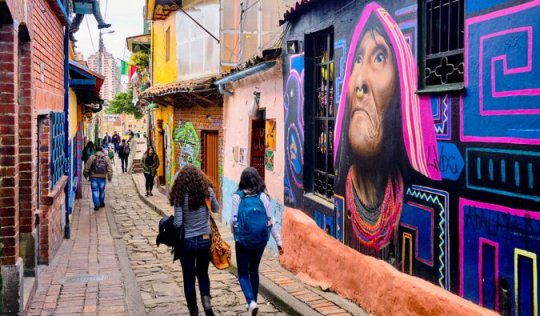
One of my favorite things to do when I get to a new destination is to take a free walking tour. It’s a great way to get the lay of the land, see the main sights, and have a local expert answer any and all of my questions.
BeyondColombia has a great free walking tour that will give you a solid introduction to the city. It also has a free food tour, which is a terrific way to get a taste of some local Colombian dishes (you’ll spend around 18,000 COP/$6 USD on food for the tour). Just be sure to tip your guides!
For a more specialized tour, check out the Bogotá Graffiti Tour. This one operates by donation, using the money raised to reinvest in future community art projects.
2. Stroll in the Botanical Gardens

Opened in 1955, the Botanical Garden of Bogotá is home to almost 20,000 plants. There is a focus on regional plants, usually those that are endemic to the Andes and other high-alpine regions of the continent. It’s a really peaceful place to walk around, and there are some food stalls nearby, so you can grab a quick bite as you explore the gardens and browse the exotic flowers and trees.
Cl. 63 No. 6895, +57 1-437-7060, jbb.gov.co. Open daily 8am-5pm (9am-5pm on weekends). Admission is 3,500 COP for adults and 1,800 COP for children.
3. Climb Monserrate
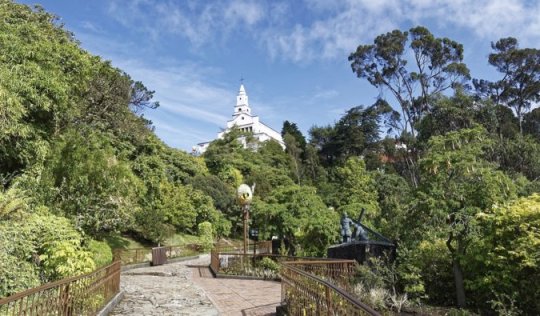
Standing tall at over 3,000 meters, you can see Monserrate from pretty much everywhere in town. It’s a popular spot to take in the view, and since there is a church at the summit, it’s also a popular spot for local weddings. You can walk up yourself in under an hour, or you can take a cable car or funicular to the top. Keep in mind that the walk up isn’t that safe at night or alone — thieves scout out the route. Be careful!
The funicular runs Monday-Saturday 6:30am-11:30am and Sundays 5:30am-4:30pm. The cable car is available Monday-Saturday 12pm-11:30pm and Sundays 10am-4:30pm. Tickets for either vehicle are the same price: round-trip tickets cost 21,000 COP for adults (12,000 COP on Sundays).
4. Visit the Museo del Oro (The Gold Museum)

This is the most interesting museum in the entire country and sees over half a million tourists every year. Opened in 1939, the Gold Museum documents the importance and use of gold in pre-Hispanic civilizations in Colombia and is home to over 55,000 gold items. There’s a lot of information to take in, so be sure to get the audio guide (8,000 COP) or join one of the daily free tours.
Cra. 6 No. 15-88, +57 1-343-2222, banrepcultural.org/bogota/museo-del-oro. Open Tuesday-Saturday 9am-6pm and Sundays 10am-4pm. Admission is 4,000 COP for adults and free for children. Admission is also free for adults on Sundays, but it gets busy quickly so be sure to arrive early!
5. See the Salt Cathedral
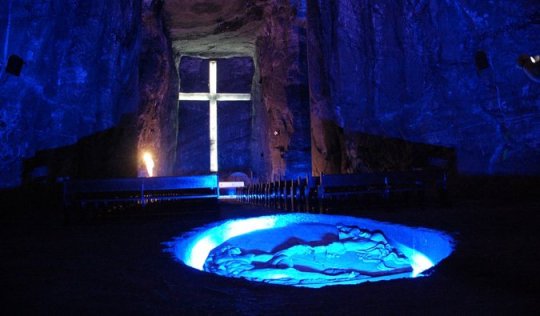
Located about an hour’s drive from the city in Zipaquirá, the Salt Cathedral is a Roman Catholic church that was built in the tunnels of an old salt mine. It’s 200 meters below ground, making this one of the more unique religious sites in the country, if not the world. Every Sunday, up to 3,000 people attend church services here.
Parque de la Sal, +57 315-760-7376, catedraldesal.gov.co. Open daily 9am-5:40pm. Admission is 58,000 COP for foreigners, with discounts available for seniors.
6. Check out the Museo de Botero

Founded in 2000, this museum is home to one of Latin America’s most important art collections. The museum was created after Fernando Botero donated hundreds of his works to the Banco de la República de Colombia with the promise that they would be displayed in a free museum for everyone to see. In addition to his own pieces, included in the donation were works by Monet, Picasso, and other world-famous artists. Take a free tour or get the audio guide (not free).
Cl. 11 No. 4-41, +57 1-343-1316, banrepcultural.org/bogota/museo-botero. Open Monday and Wednesday-Saturday 9am-7pm and Sundays 10am-5pm (closed Tuesdays). Admission is free, and free guided tours are available daily; see the website for updated times. Audio guides are available for 10,000 COP.
7. Explore La Candelaria

I really loved this neighborhood. This is the old part of Bogotá. You can wander the narrow cobblestone streets and take in the eclectic architecture, with art deco, colonial, and baroque styles all calling the neighborhood home. Many of the city’s best attractions (also, many hostels) are here too, such as the Botero Museum, the Gold Museum, and several churches and universities. Watch live music while hanging at Plaza Chorro de Quevedo, try the local chicha (a drink made from corn, often fermented to be alcoholic) on the side streets, and take in some of the amazing restaurants in this district.
8. See the Santuario Nuestra Señora del Carmen

The National Shrine of Our Lady of Carmen is a Gothic church located in La Candelaria. The church has a red-and-white striped pattern — both on the outside and inside — making it look like a giant candy cane. Built from 1926 to 1938, the church stands almost 60 meters tall has some incredible Byzantine and Moorish art.
Cra. 5 No. 8-36, +57 1-342-0972. Open Monday-Friday 7am-7:30am and 10am-4pm, Saturdays 7am-7:30am, and Sundays 7am-12:30pm.
9. Visit Simon Bolívar Metropolitan Park

This is one of the most popular parks in Bogotá. Created in 1979, it spans almost 1,000 acres. You can find people exercising, relaxing, or attending concerts here. The park is named after the famous Simón Bolívar, who led the liberation of the region from its Spanish overlords.
Open daily 6am-6pm. Admission is free unless there is a concert or event in progress.
10. Wander Plaza Bolívar
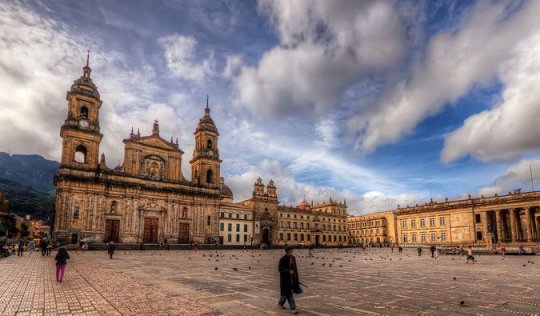
This is the main square of Bogotá, home to Colombia’s Palace of Justice, the Cathedral of Bogotá, the mayor’s office, and the Capitol Building. It’s the historical heart of the city, with buildings from as early as the 16th century. Under the Spanish, the plaza was home to bullfights, circus acts, and public markets. Watch out for the plethora of pigeons!
11. Head to the Laguna de Guatavita (Lake Guatavita)
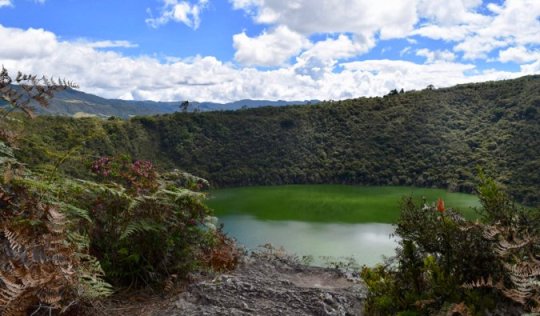
If you want to take a break from the city and get some fresh air, head out on a day trip to Lake Guatavita. Located around 60 kilometers north of Bogotá, this small lake is a sacred site to the region’s indigenous people and is apparently where the rumors of El Dorado originated. There are also hot springs in the nearby town of Sesquilé if you’re in need of some relaxation.
Day trips to the area last around 6 hours and will vary in price. Expect to pay at least 180,000 COP per person.
12. Explore Parque 93

This is the area of town with some of the best restaurants, nightclubs, and bars in the entire city. The park itself is home to an ongoing rotation of temporary art exhibitions. Located in one of the nicer areas of town, you’ll find a lot of good restaurants and cafés lining the park.
13. Attend Gringo Tuesdays
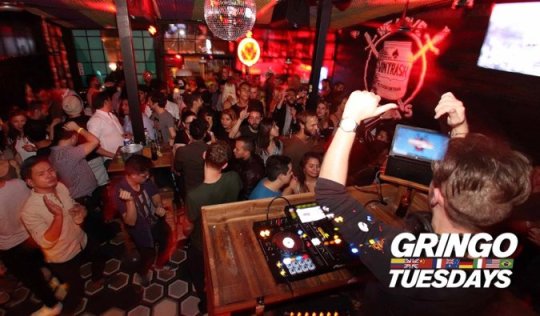
This is a weekly language exchange that evolves into an international party. Every Tuesday, you can meet with other locals and travelers for a few hours of conversation. Once that’s over, the real party begins and goes late into the night. It’s a fun, social night out if you’re looking meet fellow travelers. A lot of hostels organize party buses to the event, so if you’re coming from La Candelaria, this is a good transportation option.
Street 85 No. 11-53, Promenade del Faro, +57 311-492-0249, gringotuesdays.com/en. Every Tuesday, the language exchange occurs 4pm-8pm, followed by the party, which runs 8pm-3am.
14. Discover the National Museum of Colombia
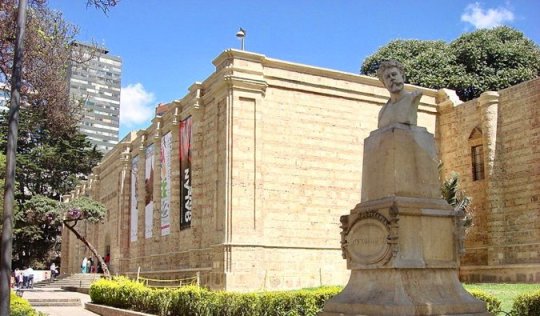
Situated in the heart of Bogotá, this is the oldest and biggest museum in the entire country (and one of the oldest on the continent). Built in 1823, it’s home to over 20,000 pieces of art and historical artifacts, some dating as far back as 10,000 BCE. The building was actually used as a prison initially (it definitely looks imposing) until it transitioned into a museum in 1946. If you’re a history buff or just want to learn more about the country, this museum is a must.
Carrera 7 No 28-66, +57 1-381-6470, museonacional.gov.co. Open Monday-Saturday 10am-6pm and Sundays 10am-5pm. Admission is 4,000 COp for adults, 3,000 COP for students, and 2,000 COP for children aged 5-12.
15. Wander the Usaquén Market
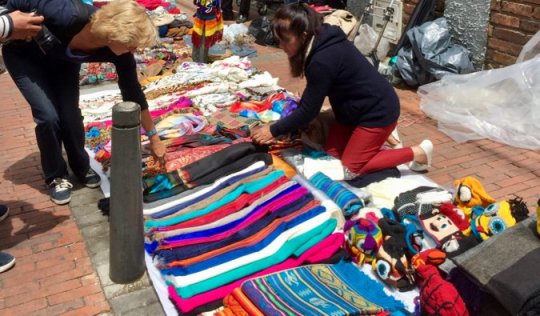
Every Sunday, artisans line the cobblestoned streets to sell all sorts of local crafts and goods. While it’s usually referred to as a flea market, things here are a bit nicer and more upscale than some of the other markets. It’s still quite affordable, though, and makes for a fun way to spend the day.
The market runs 11am-4pm every Sunday in Usaquén.
16. Explore the Museo Santa Clara

This church was built in the 17th century and is actually one of the oldest in the entire country. It was deconsecrated in the 1960s and converted into a museum by the government. There are over 148 baroque paintings that almost entirely cover its walls, making this one of the most beautifully decorated churches you’ll see in Colombia.
Cra. 8 No. 8-91, +57 1-337-6762, museocolonial.gov.co. Open Tuesday-Friday 9am-4:30pm and Saturday-Sunday 10am-3:30pm. Admission is 4,000 COP for adults and 2,000 COP for children.
17. Grab a snack from La Puerta Falsa

This little shop has been serving locals for over 200 years! La Puerta Falsa (The False Door) is a small restaurant with room for fewer than 20 people, yet the tamales and ajiaco soup have been community staples for generations. If you’re looking to try traditional Colombian food, this is the place to go!
Calle 11 No. 6-50, +57 1-286-5091, restaurantelapuertafalsa.inf.travel. Open daily 7am-10pm though its schedule isn’t set in stone.
18. Visit the Iglesia de San Francisco

Built in the 16th century, this Catholic church is the oldest surviving church in Bogotá. The interior is incredibly ornate, with a beautiful altar that dates back to the 17th century. It’s still in use, and you’ll likely see some locals praying during your visit, so make sure to dress appropriately and be respectful.
Av. Jimenez De Quesada No. 7-10, +57 1-341-2357. Open Monday-Friday 6:30am-10:30pm; 6:30am-12:30pm and 4pm-6:30pm on Saturdays; and 7:30am-1:30pm and 4:30-7:30pm on Sundays. Admission is free.
19. Sample the local brews
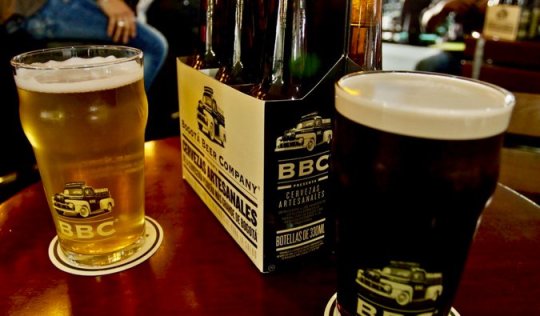
Bogotá (and the country has a whole) has a growing craft beer scene. Bogotá Craft Beer offers a four-hour tour that takes you to some of the best bars and breweries in town. The tour includes a knowledgable guide as well as secure transportation from place to place. I highly recommend it.
Tours are available daily 4pm-9pm and need to be booked in advance via their website. Tickets are around 95,000 COP per person.
20. Take a food tour

Bogotá is a great city for foodies, and the best way to get a sense of the culinary offerings is to take a food tour. Bogotá Food Tour will take you around La Macarena, Bogotá’s bohemian and artistic neighborhood. The tour lasts three hours and will take you to three different restaurants where you can sample a local dish and drink. Tours also include pickup and drop-off at your accommodation.
Tours are available Monday-Saturday and begin around 7pm. Booking in advance is required so you can secure your transportation. Tickets are 188,500 COP per person.
***
It’s true that Bogotá is an “edgy city” with a lot of petty crime. Yet I loved the atmosphere and vibe of the city. It had grit (kind of like Naples, Italy). I loved the art, the museums, the food. The city has so much to offer travelers. You can really fill a lot of time between all the sights, tours, parks, and activities. I would have liked to stay longer in Bogotá if I could.
I’d budget three to five days for your visit. It will definitely be worth it.
Book Your Trip to Colombia: Logistical Tips and Tricks
Book Your Flight
Find a cheap flight by using Skyscanner or Momondo. They are my two favorite search engines because they search websites and airlines around the globe, so you always know no stone is being left unturned.
Book Your Accommodation
You can book your hostel with Hostelworld. If you want to stay somewhere other than a hostel, use Booking.com as they consistently return the cheapest rates for guesthouses and cheap hotels. I use them all the time. My favorite places to stay are:
Masaya Hostel – This is a cool hostel located in La Candaleria. It has lots of common space where you can meet people and some comfy hammocks you can relax in; it also hosts all sorts of activities and excursions, from live music to salsa lessons.
Botánico Hostel – This cool hostel is relvatively new. The beds are comfy, it’s in a good location, and it offers free breakfast too!
Don’t Forget Travel Insurance
Travel insurance will protect you against illness, injury, theft, and cancellations. It’s comprehensive protection in case anything goes wrong. I never go on a trip without it, as I’ve had to use it many times in the past. I’ve been using World Nomads for ten years. My favorite companies that offer the best service and value are:
World Nomads (for everyone below 70)
Insure My Trip (for those over 70)
Looking for the best companies to save money with?
Check out my resource page for the best companies to use when you travel! I list all the ones I use to save money when I travel — and I think they will help you too!
Want More Information on Colombia?
Be sure to visit our robust destination guide on Colombia for even more planning tips!
Photo credits: 13, 14, 15, 16, 17, 18, 21, 20, 21
The post 20 Things to See and Do in Bogotá appeared first on Nomadic Matt's Travel Site.
from Traveling News https://www.nomadicmatt.com/travel-blogs/things-to-see-and-do-in-bogota/
0 notes
Text
20 Things to See and Do in Bogotá
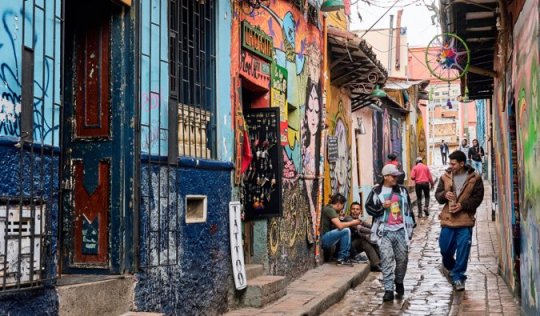
Posted: 03/25/2019 | March 25th, 2019
The capital of Colombia, Bogotá was the home to the region’s indigenous people, the Muisca, when the Spanish came around plundering gold and resources, and it’s been the country’s main city ever since.
Before I went, everyone told me Bogotá wasn’t anything special: dirty, crowded, hard to get around, and lacking the charm of the other big cities in Colombia.
“Spend a few days there and move on,” they all said.
Well, I spent a few days there — and then a few more.
I LOVED Bogotá.
It felt like the most “Colombian” city I visited. It’s not like the gringofied cities in the rest of the country. Its “gritty” nature was what appealed to me.
Bogotá was a vibrant, lively city I couldn’t get enough of.
The museum scene is incredible, there’s a lot of history, a blossoming art community, an exciting food scene, a wild nightlife, and super welcoming people.
It is also a huge city with a ton of tours, day trips, and other things to do. You could easily spend a week here.
To help you make the most out of your visit, here are my top 20 things to see and do in Bogotá.
20 Things to See and Do in Bogotá
1. Take a Free Walking Tour

One of my favorite things to do when I get to a new destination is to take a free walking tour. It’s a great way to get the lay of the land, see the main sights, and have a local expert answer any and all of my questions.
BeyondColombia has a great free walking tour that will give you a solid introduction to the city. It also has a free food tour, which is a terrific way to get a taste of some local Colombian dishes (you’ll spend around 18,000 COP/$6 USD on food for the tour). Just be sure to tip your guides!
For a more specialized tour, check out the Bogotá Graffiti Tour. This one operates by donation, using the money raised to reinvest in future community art projects.
2. Stroll in the Botanical Gardens
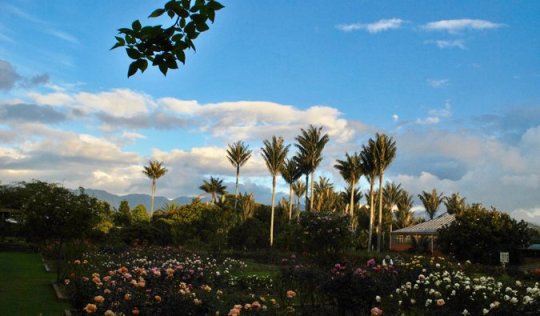
Opened in 1955, the Botanical Garden of Bogotá is home to almost 20,000 plants. There is a focus on regional plants, usually those that are endemic to the Andes and other high-alpine regions of the continent. It’s a really peaceful place to walk around, and there are some food stalls nearby, so you can grab a quick bite as you explore the gardens and browse the exotic flowers and trees.
Cl. 63 No. 6895, +57 1-437-7060, jbb.gov.co. Open daily 8am-5pm (9am-5pm on weekends). Admission is 3,500 COP for adults and 1,800 COP for children.
3. Climb Monserrate
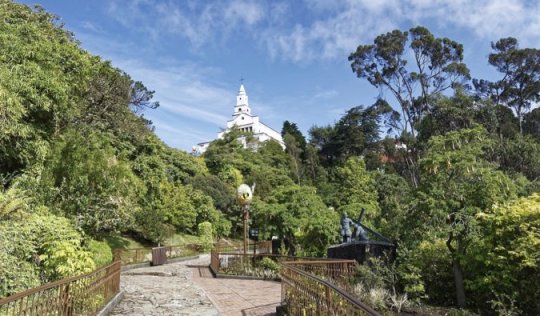
Standing tall at over 3,000 meters, you can see Monserrate from pretty much everywhere in town. It’s a popular spot to take in the view, and since there is a church at the summit, it’s also a popular spot for local weddings. You can walk up yourself in under an hour, or you can take a cable car or funicular to the top. Keep in mind that the walk up isn’t that safe at night or alone — thieves scout out the route. Be careful!
The funicular runs Monday-Saturday 6:30am-11:30am and Sundays 5:30am-4:30pm. The cable car is available Monday-Saturday 12pm-11:30pm and Sundays 10am-4:30pm. Tickets for either vehicle are the same price: round-trip tickets cost 21,000 COP for adults (12,000 COP on Sundays).
4. Visit the Museo del Oro (The Gold Museum)

This is the most interesting museum in the entire country and sees over half a million tourists every year. Opened in 1939, the Gold Museum documents the importance and use of gold in pre-Hispanic civilizations in Colombia and is home to over 55,000 gold items. There’s a lot of information to take in, so be sure to get the audio guide (8,000 COP) or join one of the daily free tours.
Cra. 6 No. 15-88, +57 1-343-2222, banrepcultural.org/bogota/museo-del-oro. Open Tuesday-Saturday 9am-6pm and Sundays 10am-4pm. Admission is 4,000 COP for adults and free for children. Admission is also free for adults on Sundays, but it gets busy quickly so be sure to arrive early!
5. See the Salt Cathedral
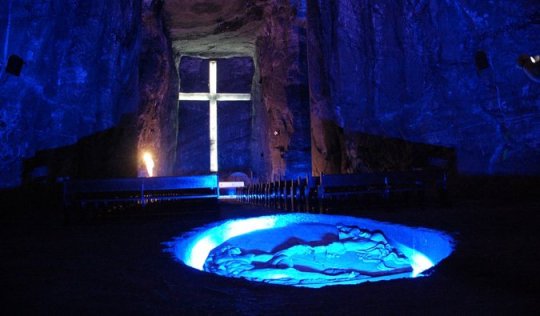
Located about an hour’s drive from the city in Zipaquirá, the Salt Cathedral is a Roman Catholic church that was built in the tunnels of an old salt mine. It’s 200 meters below ground, making this one of the more unique religious sites in the country, if not the world. Every Sunday, up to 3,000 people attend church services here.
Parque de la Sal, +57 315-760-7376, catedraldesal.gov.co. Open daily 9am-5:40pm. Admission is 58,000 COP for foreigners, with discounts available for seniors.
6. Check out the Museo de Botero

Founded in 2000, this museum is home to one of Latin America’s most important art collections. The museum was created after Fernando Botero donated hundreds of his works to the Banco de la República de Colombia with the promise that they would be displayed in a free museum for everyone to see. In addition to his own pieces, included in the donation were works by Monet, Picasso, and other world-famous artists. Take a free tour or get the audio guide (not free).
Cl. 11 No. 4-41, +57 1-343-1316, banrepcultural.org/bogota/museo-botero. Open Monday and Wednesday-Saturday 9am-7pm and Sundays 10am-5pm (closed Tuesdays). Admission is free, and free guided tours are available daily; see the website for updated times. Audio guides are available for 10,000 COP.
7. Explore La Candelaria
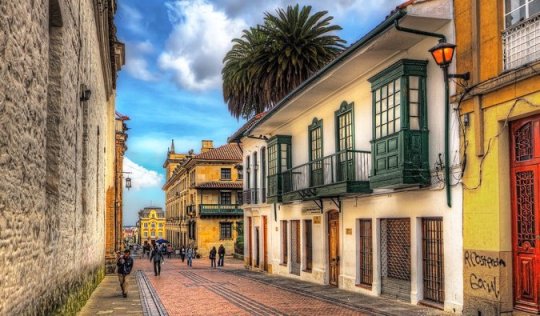
I really loved this neighborhood. This is the old part of Bogotá. You can wander the narrow cobblestone streets and take in the eclectic architecture, with art deco, colonial, and baroque styles all calling the neighborhood home. Many of the city’s best attractions (also, many hostels) are here too, such as the Botero Museum, the Gold Museum, and several churches and universities. Watch live music while hanging at Plaza Chorro de Quevedo, try the local chicha (a drink made from corn, often fermented to be alcoholic) on the side streets, and take in some of the amazing restaurants in this district.
8. See the Santuario Nuestra Señora del Carmen

The National Shrine of Our Lady of Carmen is a Gothic church located in La Candelaria. The church has a red-and-white striped pattern — both on the outside and inside — making it look like a giant candy cane. Built from 1926 to 1938, the church stands almost 60 meters tall has some incredible Byzantine and Moorish art.
Cra. 5 No. 8-36, +57 1-342-0972. Open Monday-Friday 7am-7:30am and 10am-4pm, Saturdays 7am-7:30am, and Sundays 7am-12:30pm.
9. Visit Simon Bolívar Metropolitan Park
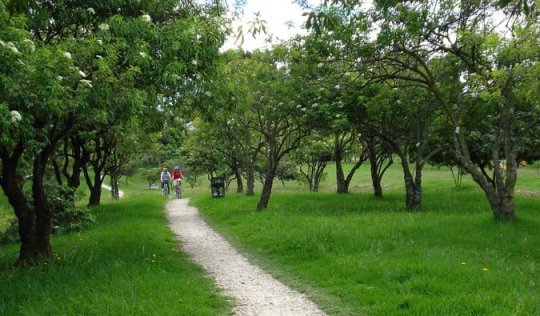
This is one of the most popular parks in Bogotá. Created in 1979, it spans almost 1,000 acres. You can find people exercising, relaxing, or attending concerts here. The park is named after the famous Simón Bolívar, who led the liberation of the region from its Spanish overlords.
Open daily 6am-6pm. Admission is free unless there is a concert or event in progress.
10. Wander Plaza Bolívar

This is the main square of Bogotá, home to Colombia’s Palace of Justice, the Cathedral of Bogotá, the mayor’s office, and the Capitol Building. It’s the historical heart of the city, with buildings from as early as the 16th century. Under the Spanish, the plaza was home to bullfights, circus acts, and public markets. Watch out for the plethora of pigeons!
11. Head to the Laguna de Guatavita (Lake Guatavita)

If you want to take a break from the city and get some fresh air, head out on a day trip to Lake Guatavita. Located around 60 kilometers north of Bogotá, this small lake is a sacred site to the region’s indigenous people and is apparently where the rumors of El Dorado originated. There are also hot springs in the nearby town of Sesquilé if you’re in need of some relaxation.
Day trips to the area last around 6 hours and will vary in price. Expect to pay at least 180,000 COP per person.
12. Explore Parque 93
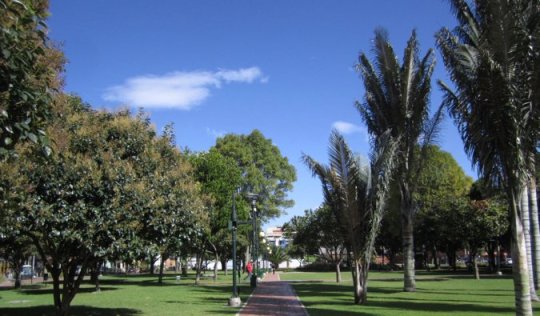
This is the area of town with some of the best restaurants, nightclubs, and bars in the entire city. The park itself is home to an ongoing rotation of temporary art exhibitions. Located in one of the nicer areas of town, you’ll find a lot of good restaurants and cafés lining the park.
13. Attend Gringo Tuesdays

This is a weekly language exchange that evolves into an international party. Every Tuesday, you can meet with other locals and travelers for a few hours of conversation. Once that’s over, the real party begins and goes late into the night. It’s a fun, social night out if you’re looking meet fellow travelers. A lot of hostels organize party buses to the event, so if you’re coming from La Candelaria, this is a good transportation option.
Street 85 No. 11-53, Promenade del Faro, +57 311-492-0249, gringotuesdays.com/en. Every Tuesday, the language exchange occurs 4pm-8pm, followed by the party, which runs 8pm-3am.
14. Discover the National Museum of Colombia
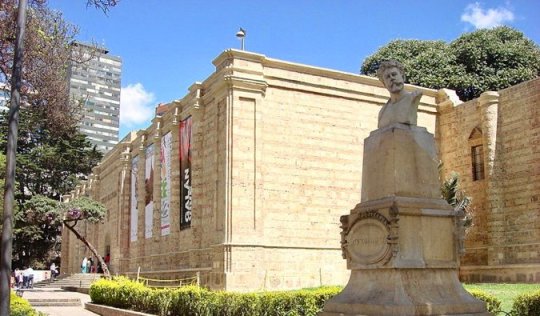
Situated in the heart of Bogotá, this is the oldest and biggest museum in the entire country (and one of the oldest on the continent). Built in 1823, it’s home to over 20,000 pieces of art and historical artifacts, some dating as far back as 10,000 BCE. The building was actually used as a prison initially (it definitely looks imposing) until it transitioned into a museum in 1946. If you’re a history buff or just want to learn more about the country, this museum is a must.
Carrera 7 No 28-66, +57 1-381-6470, museonacional.gov.co. Open Monday-Saturday 10am-6pm and Sundays 10am-5pm. Admission is 4,000 COp for adults, 3,000 COP for students, and 2,000 COP for children aged 5-12.
15. Wander the Usaquén Market

Every Sunday, artisans line the cobblestoned streets to sell all sorts of local crafts and goods. While it’s usually referred to as a flea market, things here are a bit nicer and more upscale than some of the other markets. It’s still quite affordable, though, and makes for a fun way to spend the day.
The market runs 11am-4pm every Sunday in Usaquén.
16. Explore the Museo Santa Clara

This church was built in the 17th century and is actually one of the oldest in the entire country. It was deconsecrated in the 1960s and converted into a museum by the government. There are over 148 baroque paintings that almost entirely cover its walls, making this one of the most beautifully decorated churches you’ll see in Colombia.
Cra. 8 No. 8-91, +57 1-337-6762, museocolonial.gov.co. Open Tuesday-Friday 9am-4:30pm and Saturday-Sunday 10am-3:30pm. Admission is 4,000 COP for adults and 2,000 COP for children.
17. Grab a snack from La Puerta Falsa

This little shop has been serving locals for over 200 years! La Puerta Falsa (The False Door) is a small restaurant with room for fewer than 20 people, yet the tamales and ajiaco soup have been community staples for generations. If you’re looking to try traditional Colombian food, this is the place to go!
Calle 11 No. 6-50, +57 1-286-5091, restaurantelapuertafalsa.inf.travel. Open daily 7am-10pm though its schedule isn’t set in stone.
18. Visit the Iglesia de San Francisco
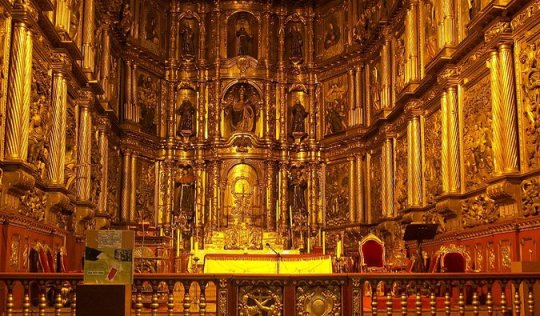
Built in the 16th century, this Catholic church is the oldest surviving church in Bogotá. The interior is incredibly ornate, with a beautiful altar that dates back to the 17th century. It’s still in use, and you’ll likely see some locals praying during your visit, so make sure to dress appropriately and be respectful.
Av. Jimenez De Quesada No. 7-10, +57 1-341-2357. Open Monday-Friday 6:30am-10:30pm; 6:30am-12:30pm and 4pm-6:30pm on Saturdays; and 7:30am-1:30pm and 4:30-7:30pm on Sundays. Admission is free.
19. Sample the local brews
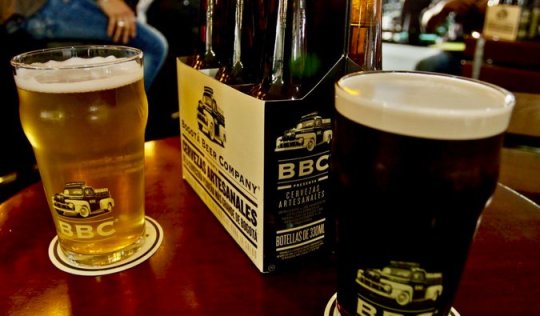
Bogotá (and the country has a whole) has a growing craft beer scene. Bogotá Craft Beer offers a four-hour tour that takes you to some of the best bars and breweries in town. The tour includes a knowledgable guide as well as secure transportation from place to place. I highly recommend it.
Tours are available daily 4pm-9pm and need to be booked in advance via their website. Tickets are around 95,000 COP per person.
20. Take a food tour

Bogotá is a great city for foodies, and the best way to get a sense of the culinary offerings is to take a food tour. Bogotá Food Tour will take you around La Macarena, Bogotá’s bohemian and artistic neighborhood. The tour lasts three hours and will take you to three different restaurants where you can sample a local dish and drink. Tours also include pickup and drop-off at your accommodation.
Tours are available Monday-Saturday and begin around 7pm. Booking in advance is required so you can secure your transportation. Tickets are 188,500 COP per person.
***
It’s true that Bogotá is an “edgy city” with a lot of petty crime. Yet I loved the atmosphere and vibe of the city. It had grit (kind of like Naples, Italy). I loved the art, the museums, the food. The city has so much to offer travelers. You can really fill a lot of time between all the sights, tours, parks, and activities. I would have liked to stay longer in Bogotá if I could.
I’d budget three to five days for your visit. It will definitely be worth it.
Book Your Trip to Colombia: Logistical Tips and Tricks
Book Your Flight
Find a cheap flight by using Skyscanner or Momondo. They are my two favorite search engines because they search websites and airlines around the globe, so you always know no stone is being left unturned.
Book Your Accommodation
You can book your hostel with Hostelworld. If you want to stay somewhere other than a hostel, use Booking.com as they consistently return the cheapest rates for guesthouses and cheap hotels. I use them all the time. My favorite places to stay are:
Masaya Hostel – This is a cool hostel located in La Candaleria. It has lots of common space where you can meet people and some comfy hammocks you can relax in; it also hosts all sorts of activities and excursions, from live music to salsa lessons.
Botánico Hostel – This cool hostel is relvatively new. The beds are comfy, it’s in a good location, and it offers free breakfast too!
Don’t Forget Travel Insurance
Travel insurance will protect you against illness, injury, theft, and cancellations. It’s comprehensive protection in case anything goes wrong. I never go on a trip without it, as I’ve had to use it many times in the past. I’ve been using World Nomads for ten years. My favorite companies that offer the best service and value are:
World Nomads (for everyone below 70)
Insure My Trip (for those over 70)
Looking for the best companies to save money with?
Check out my resource page for the best companies to use when you travel! I list all the ones I use to save money when I travel — and I think they will help you too!
Want More Information on Colombia?
Be sure to visit our robust destination guide on Colombia for even more planning tips!
Photo credits: 13, 14, 15, 16, 17, 18, 21, 20, 21
The post 20 Things to See and Do in Bogotá appeared first on Nomadic Matt's Travel Site.
source https://www.nomadicmatt.com/travel-blogs/things-to-see-and-do-in-bogota/
0 notes
Text
31 Best Places To Visit in France: Culture, Cuisine, Wine & Nature
With so many places to visit in France, it’s no wonder that it has remained one of the most touristed countries on the planet – with over 82 million people visiting the land of food, fashion, romance and wine each year.
France is blessed with natural beauty, a rich history, intricate architecture, iconic art, world-class grape-producing vineyards and a deep passion for life.
France has long been a foodie and wine-lovers paradise, but dive deeper beneath the cuisine and viticulture and you’ll find a place with welcoming people, a long-standing sophisticated culture and an intoxicating romantic ambiance that seduces almost every person who touches down in L’hexagone.
In this article, I’m going to list many of the best places to visit in France, but because the country has so much to offer, I’m going to break the places up into 5 categories: History, Wine, Food, Nature & Culture.
Here’s a bucket list of all of the best places to visit in France!
Places To Visit in France For History
With the first written records of the history of France dating back to the Iron Age, and inhabitants that have gone as far back as Gauls, the Aquitani, and the Belgae, it’s no surprise that France is a place where people flock to witness living history.
Walking around a medieval village in France can feel a bit like you just stepped out of a time machine and despite the nation’s growing population and exploding number of visitors, there are still pockets of France that move at a contiguously slow pace.
Here are some of the best places to visit in France for history-buffs:
1. Saint Malo, Brittany
This city is actually part of the English Channel and it is one of the most conspicuously picturesque historical places to visit in France.
There is plenty of well-preserved architecture to see here, including Fort National and the Malo Cathedral, but there is also a rich history of pirates and seafarers that once ran this town.
In the middle ages, this was an important port and today it sees more and more tourists every year who come for fresh seafood, historical ambiance and delicious local cuisine.
To get to Brittany, your best bet is to check out Brittany Ferries who offer convenient cross Channel ferries to France, with the widest choice of ferry crossings available anywhere.
If you’re in the UK, you can depart from Portsmouth, Plymouth or Poole and travel to Cherbourg, St Malo, Caen, Le Havre or Roscoff for a direct Channel crossing to France.
Best Tours in Brittany (click to view tours):
☞ Click Here to see more tours in Brittany
2. Le Mont St Michel
Built on an 83-meter high granite cliff that juts out of the bay of Normandy, the island town of Le Mont St Michel is truly a sight to behold.
An important pilgrimage site for over a millennium, it’s no surprise that this is one of the best historical places to visit in France, featuring the Benedictine Abbey with the statue of the arc angle (said to have visited the country in the 8th century) placed triumphantly at its precipice.
Le Mont St Michel, simply put, has a particular magic to it.
Make sure you climb the cobbled steps to the top of the abbey where you can enjoy the expansive views over the sea and the surrounding countryside, as well as the ancient medieval town that sprawls out on the landscape below.
3. Espelette
Famous for its castle and many traditional houses, the views of Espelette are extraordinary. Also known for the spicy pepper of the same name, Espelette has wowed visitors for centuries, both with its spice and its sights.
Try to time your visit for fall, when the leaves change and the town comes alive with autumn colours. Particularly if you can make it here for the last week of October, you’ll be able to experience the pepper festival!
4. Yvoire, Rhône-Alpes
This is without a doubt one of the most beautiful places to visit in France.
Stretching over the vast shores of Lake Geneva, this 14th-century medieval town boasts a lovely garden, countless flowers and fruits, a vast maze of cobblestone streets, fascinating historical architecture and a “back-in-time” atmosphere.
History buffs shouldn’t miss Visite d’Yvoire, the Garden of 5 Senses, Helionaute and La Chataigniere. But everyone who visits Yvoire should simply get lost in the labyrinth of back streets, stopping only to pop in for a quick pastry or a delicious espresso.
Best Tours in Yvoire (click to view tours):
☞ Click Here to see more tours in Yvoire
5. Bayeux
For history and historical tapestry, visitors will be wowed by the Bayeux Museum, which gives you an up-close and personal look into art history in France.
One particular piece in the museum is nearly the length of a football field and has some of the most intricately embroidered and well-preserved tapestry you’ll ever see.
Outside of the museum, the tiny little town of Bayeux is notorious for producing delicious French pastries and it also boasts a gorgeous cathedral and a lovely old quarter.
To try some of Normandy’s famous local brandy and a traditional Normand meal, head to L’Assiette Normande restaurant, which is located just up the road from the Cathedral.
6. Colmar, Alsace
If you’re looking for history and romance all wrapped up in a small package that looks a bit like Venice, don’t miss Petite Venise in Colmar, or the charming streets in the inner city.
Its proximity to the German border gives Colmar a unique position in history as it has been handed back and forth between the French and the Germans for nearly 1000 years.
This historical hot potato game has left Colmar with a unique blend of German and French influences that can be seen within almost every aspect of the city, including the architecture, food, traditions and language.
Here you can indulge in beer, schnitzels and pretzels one day, and take a wonderful food and wine tasting tour the next.
7. Sainte-Mère-Église
Another of the historical places to visit in France, Sainte-Mère-Église was the first town to be liberated by the Allied Forces on D-Day.
You can visit Sainte-Mère-Église throughout the year, but many like to come on the anniversary of D-day when you can celebrate its anniversary with the locals. You’ll find food in the streets and enjoy the festive atmosphere.
8. Avignon
With over 4 million tourists visiting the city every year, Avignon is without a doubt one of the most popular historical places to visit in France, particularly when compared to other places in the south-eastern part of the country.
Pretty much anyone who heads this way has to stop in Avignon. This UNESCO world heritage site was first founded in the early 6th century BC and features the unmistakable Palace of the Popes, as well as many other historical sites.
Now best known for hosting the largest annual arts festival in France, Avignon also boasts a medieval bridge, leafy plazas and open squares, world-class restaurants and an endlessly charming old town.
A great way to see the ramparts of the historical quarter is by hopping on a boat tour down the Rhône river.
Best Tours in Avignon (click to view tours):
☞ Click Here to see more tours in Avignon
9. Gordes, Provence
Because Gordes also hosts an amazing wine festival at the beginning of August and an almond festival in Spring, I could have easily placed the city under the “best places to visit in France for wine” or the “best places to visit in France for food” instead, but there’s just too much history and medieval architecture here to move it out of the historical category.
Arguably the most picturesque hilltop village in the country, the terracotta-roof homes and ancient church towers of Gordes huddle close together, precariously teetering on the edge of a sheer rock cliff above the Vaucluse Plateau.
The spectacular view of the village from afar looks like something straight out of Game of Thrones.
Don’t just get lost inside of the town itself, be sure to head out on the plateau for sunset to see Gordes truly alight with a golden hue as the sun dips into the horizon.
Be warned though, during summer months this tiny village is bursting at the seams as visitor numbers rise along with the temperatures and accommodation prices.
Places To Visit in France For Food
French is one of the best cuisines in the world and it seems to always conjure up images of fine dining, fine wine and borderline pretentious portion sizes, but dig deeper into this land of culinary fusion and you’ll find that the soul of French cooking is found in the ingredients themselves and the techniques used to prepare the dishes.
The flavours are sophisticated, but not overly complex and often focus on creating a harmonious dish that elevates a single featured ingredient.
Don’t be fooled into thinking that every French restaurant is high-end dining either. You’ll still find some cheap little gems (even in Paris) and definitely don’t miss the informal bouchons of Lyon or the budget bistros of Bordeaux.
Here are the best places to visit in France for foodies:
10. Grenoble
Tucked beneath the towering Alps in southeastern France, Grenoble has boldly taken on the flavours and ingredients of its Swiss and Italian neighbours, with wonderful Swiss-Alpine and Italian influence found in many of the dishes here.
Grenoble has been blessed by a position at an intersection of cuisine and this has attributed to its gourmet excellence, which has slowly been perfected over the centuries.
A place fringed by walnut orchards which produce more than half of France’s total annual harvest, it’s no surprise that the plentiful nut is found in so many of Grenoble’s tasty pastries and decadent desserts.
For the best restaurants, don’t miss the city center where you’ll find countless patisseries and fine dining restaurants like the wonderful La Madelon. But don’t worry, not everything is at the top-end of the spectrum here.
If you’re visiting on a budget, there are a few cheaper hotels in the city and the large student population definitely helps bring down the food costs, creating a market for more budget-friendly eating options like Barbecue Damas and Green Mango ice cream shop.
11. Lille
Located in the far north of France, it’s no wonder why there’s so much Flemish influence in the cuisine here, with beer and hops frequently appearing on the ingredients list for many dishes in town.
There are also wonderful chocolate shops spattered throughout the village. Basically, if you’re coming to France for food, you’ll want to come to Lille and truly treat your palate to some of France’s most unique and flavourful cuisine.
If you’re into meaty meals like beer stewed beef, meat and veggie terrines and fantastic fresh seafood plates, then Lille may just be your culinary paradise.
Foodies should definitely stop in at A L’Huîtrière if they’re looking for seafood, but also the aptly named former butcher’s shop of Le Barbier Lillois makes for a great dining out experience.
Best Tours in Lille (click to view tours):
☞ Click Here to see more tours in Lille
12. Dijon
When a town is literally known more for the food it creates than for being an actual place, you know it’s going to be one of the best places to visit in France for food-lovers.
As the capital of wine-crazed Burgandy, Dijon has constantly been listed amongst France’s top culinary destinations and of course, you can enjoy mustard alongside wine all day long here.
If you’re in Dijon for the food, don’t miss the garlic butter snails, andouillette (sausage made with pig intestines), and the world-famous dishes of coq au vin and boeuf bourguignon (both are tasty red wine-based stews).
For a gourmet night out, don’t miss Le Bistrot de Halles and Le Pré aux Clercs.
Best Tours in Dijon (click to view tours):
☞ Click Here to see more tours in Dijon
13. Paris
I was actually having a really hard time trying to figure out where to put Paris on this list. The city has great wine, rich culture and of course, a lot of history… but Paris really is a foodie paradise, boasting a smörgåsbord of pâtisseries, fine dining restaurants, street food and brasseries.
The growing number of tourists has really started to tarnish the city’s culinary reputation with some restaurants abandoning their French traditions in an attempt to please foreign visitors.
This is why it’s so important to find your way off the beaten culinary path and into some of Paris’s forgotten foodie back streets.
If you’re looking for an authentic eating experience in this touristy capital, check out La Maison des Frigos, Le Foyer de la Madeleine, Chez Louisette and Saint Germain’s best-kept secret – L’Etage de Pastavino.
There are endless fun things to see and do in Paris. Many people even choose to spend just a weekend in the city enjoying the open-air museum, fabulous food and wonderful sites. Click here to learn how to spend the perfect 2 days in Paris.
youtube
Best Places To Stay in Paris:
The best value available in Paris is with Airbnbs. Find apartments that have local owners who can show you around to the local spots and introduce you to Paris through a native’s perspective. There are literally thousands of Airbnbs in Paris, so to choose the best ones, Click Here and read all about the best Paris Airbnbs for all budgets.
Best Tours in Paris (click to view tours):
☞ Click Here to see 700+ more tours in Paris.
14. Lyon
Be ready for bouchons in Lyon. These are tiny, lively and delightfully low-key restaurants found throughout the city. Their popularity exploded in the early 1930s when an economic downturn caused wealthy home-owners to fire their well-trained local chefs, who then retaliated by opening up their own restaurants to serve the less affluent in the city.
These tiny little restaurants have flourished through numerous ensuing economic crisis’ and are now one of the main reasons that people visit the captivating village of Lyon.
Similar to Grenoble, Lyon has been at a culinary crossroads, but the difference here is that the varied influences are more domestic. Today, the cuisine draws its inspiration from Beaujolais, Provence, Burgundy, and the Alps which all culminate into a savory mix of flavours that have given Lyon a culinary identity all its own.
Don’t miss the wonderful bouchons like Chez Georges and Cafe Comptoir Abel where you can try some of the city’s most famous dishes, including quenelles de brochet (skinny dumplings floating in a savory crayfish sauce).
Best Tours in Lyon (click to view tours):
☞ Click Here to see 30+ more tours in Lyon
Places To Visit in France For Wine
Currently the second-largest wine-producing nation on Earth (next to Italy), France is clearly one of the best countries in the world for wine-lovers to visit.
You really can’t go wrong when the very names of French cities conjure up images of lush reds and bright whites before you are reminded that these are actually cities and not just grape varieties.
From the hills of Bordeaux to the vineyards of Champagne, these are the best places to visit in France for wine:
15. Bordeaux
The very name rolls of the tongue in such a way that you can’t help but to think of wine. Bordeaux is found in the middle of the Gironde region which is where some of the country’s best vineyards are found.
The city itself boasts France’s longest shopping avenue, but that’s not why you’re coming to Bordeaux is it?!
You’re here for du vin and right on the city’s doorstep are some of the most famous wine-makers in the world – including Bordeaux Superieur, Entre-Deux-Mers, Medoc and Saint-Emilion.
For some lesser-known vineyards, check out d’Arsac, Beau-Site, Bellevue de Tayac and Bonnet.
I highly recommend taking a wine tour in Bordeaux so you can learn more about the history of viticulture in the area and explore the many cellars that dot the countryside before arriving safely back at your hotel with the help of a designated driver.
Top-Rated Tours in Bordeaux (click to view tours):
☞ Click Here to see more tours in Bordeaux
16. Burgundy
You’ll likely leave this place with your teeth turning the color of burgundy (the word describing the color itself is named after the deep red wines found in the region). There are just too many different wines to taste here and it’s one of the best places to enjoy a wine tour in France.
Bourgogne, as it’s said in French, is located between Auxerre and Sens in Southeastern Paris and was actually owned by the English after the Hundred Years War all the way up until 1477 when it rejoined with France.
Today it boasts a lot of important historical sites, but again… that’s probably not the main reason you’re going to visit Burgundy.
Wine enthusiasts and sommeliers have flocked to Burgundy for centuries to sample some of the world-renowned wines and tour the beautiful vineyards. Without a doubt, if you’re into wine, this is one of the best places to visit in France.
Top-Rated Tours in Burgandy:
☞ Click Here to see more tours in Burgundy
17. Champagne
Home to the endemically titled grape variety of the same name, Champagne is arguably one of France’s best places to visit for wine.
The sparkling white that made the town famous is a true French delicacy and its consumption is to be taken very seriously. Savoring the tingle on the tongue and standing in reverence of the original wine-makers is almost mandatory here.
Prepare to bring your wallet along if you plan to do tastings and buy bottles in Champagne. It’s no surprise that while the cost of a bottle here is slightly less than you may find at home, it’s still a very expensive beverage.
Top-Rated Tours in Champagne:
☞ Click Here to see more tours in Champagne
18. Bergerac & Duras
Benefiting from a warm and temperate climate, the wines of Bergerac and Duras are actually a very important part of the cultural and culinary history of the Périgord Agenais region.
The vines here produce excellent reds, whites and rosés and all are best enjoyed on a wine tour with one of the many operators in the area. A guided visit to the cellars and farm-to-table restaurants in these vineyards is a must and when you’re done sipping sumptuous vintages, you can explore some of the nearby medieval villages.
19. Provence
Blessed with Michelin starred restaurants, olive groves, cyprus forests, fruit trees and lush gardens, Provence has long been famous for its herbs and wine the world over.
This sun-kissed paradise in Southeastern France is as indulgent as it gets. I’ve already listed Avignon in this post (which is within the Provence region), but other places like Aix-en-Prevence, Cassis and Bandol also add to the allure of the area.
For wine, it’s best to come in April to September when all of the wineries are open for tasting. Head to Clos Sainte Magdeleine where you can try two wines for 12 euros, or try one of the older vineyards like Mas de Cadenet which has been producing wines since 1813.
If you’re looking to take some bottles home with you, The Maison des Vins de Côtes de Provence in Les Arcs-sur-Agens has over 800 different wines to choose from and the staff there can help you pick the perfect bottle souvenir.
Top-Rated Tours in Provence (click to view tours):
☞ Click Here to see more tours in Provence
Places To Visit in France For Nature
Despite often being overshadowed by its more famous traits such as wine, cuisine and historic villages, France is still an excellent place to visit if you want to experience nature.
From the towering powder-white peaks of the Alps, to the depths of its deepest gorges, through its hilly interior and along its jagged coastline, France is blessed with a natural beauty that, while sometimes ignored, is hard to forget once you’ve seen it.
These are the best places to visit in France if you’re interested in nature.
20. Mont Blanc
A kind of Bermuda Triangle located at the border between Italy and France, Mont Blanc is the tallest mountain found in Western Europe and has been host to numerous tragedies including skiing fatalities, tunnel fires, plane crashes and avalanches, making it one of the deadliest peaks in the world.
If you’re a mountaineer though, this 4,810 meter high peak will probably call to you. For the less adventurous, you can view the snowy behemoth from Chamonix, where most visitors base themselves to do day trips to its foothills.
21. Chamonix
Sitting at the foothills of the great Mont Blanc, Chamonix is a skiers’ paradise in the winter and a hikers’ heaven in the summer months. With a long history of winter athletics, the city was rebuilt for tourism when it hosted the first-ever Winter Olympics in 1924. Since then it has grown in popularity and boasts some of the best powdery slopes found anywhere in Europe.
If you tire of the mogul-clad mountain slopes, head back to town and pop into one of the many Michelin starred restaurants that line the main road. In the winter, Chamonix comes alive with the fever of winter sports and everyone is talking about their latest run over a delicious glass of wine or a warm cup of coffee.
Top-Rated Tour in Chamonix:
☞ Click Here to see more tours in Chamonix
22. Aiguille du Dru
Actually situated within the Mont Blanc mountain range, this comparatively small peak (at 3,750 meters high) is still an impressive sight to behold. With its steel grey granite rock face and jagged peaks, this mountain has been a formidable challenge for mountaineers since its first summit in 1878.
23. Étretat Cliffs
Found amongst farming villages in the northwestern region of Normandy, these picturesque cliffs have inspired painters, artists and writers for centuries.
The natural arches and jagged “needles” jut out of the Atlantic Ocean and offer visitors a striking visual, as well as a good opportunity to suntan and swim in the nearby pebble beaches.
24. Gorges du Verdon
This 700-meter-deep river canyon is spectacularly placed in the shadows of the French Alps and stretches for 25 kilometers in length through the Alpse-de-Haute-Provence range.
This is arguably the most beautiful gorge in Europe and thanks to the breathtaking turquoise-colored water and the dramatic topography, it’s a wonderful place for swimming, rafting, fly fishing, rock climbing and paragliding.
25. Scandola Nature Reserve
This is definitely one of the best places to visit in France if you want to enjoy nature and outdoors. Scandola Nature Reserve is found on the jagged, red stone French island of Corsica. Taking a boat from the coast, you can explore countless coves, grottos and caves which are as pristine as you’ll find anywhere on the continent.
If you tire of visiting the dramatic cliffs along the coast, consider popping into one of the lovely coastal towns near Scandola, which provide a vivid glimpse into day-to-day life on the island as well as some delicious food.
Top-Rated Tour in Scandola:
☞ Click Here to see more tours in Scandola
26. Pic du Midi d’Ossau
Lost for millenia inside of the great French Pyrenees Mountain Range, Pic du Midi d’Ossau reflects its beauty on the mirror-like waters at its base. The best views of the jagged peak are likely seen from Boulevard des Pyrénées which lies 55km north of this unmistakable natural wonder.
27. The Camargue Salt Flats
These pink-colored salt lagoons are found within The Camargue, an area best known for being the largest river delta in Western Europe.
The flats and lagoons get their fuchsia color from a salt-eating organism known as Dunaliella salina, which emits a red pigment while absorbing energy from the sun.
Strangely enough, it also turns the birds pink! This is a great place to spot pink flamingos as well as (white) Camargue horses. All-in-all, the Camargue Salt Flats are a fascinating place to visit in France.
Learn more about the unusual side of France including myths, stereotypes, unique art, and untold secrets in this blog about offbeat France.
Best Places To Visit in France For Culture
In some places, it just seems easier to mingle with locals, to indulge in culture and to understand French traditions and their way of life.
Here are some of the best places to visit in France if you’re interested in learning about and experiencing the culture:
28. Nice
Get lost in Vieille Ville, with its rustic, medieval atmosphere and iconic historic buildings all lining a delicate network of narrow back roads and tiny alleyways. Here you can enjoy delicious food and meet local people going about their day-to-day life. It’s easy to become instantly immersed in the culture of Nice.
For a little bit of art history and an understanding of its effect on local culture, check out the Museum of Modern and Contemporary Art. This striking marble building is a great example of Neoclassical architecture and was first inaugurated in June of 1990. Inside you’ll find a collection of ten galleries all spread over 370,000 square meters.
Top-Rated Tours in Nice (click to view tours):
☞ Click Here to see more tours in Nice
29. Versailles
Versailles a small city on the on western edge of Paris. It has actually now been swallowed by the enormous sprawling metropolis within the Ile de France region.
Only really visited for the enormous royal palace complex and gardens which were built by King Louis XIV, this former hunting lodge is known as The Palace of Versailles or The Château de Versailles (best seen with the amazingly rated tour below) and was the location that the Peace Treaty was signed between Germany and the Allied Forces which effectively ended WWI.
Although the palace is undoubtably Versailles’ most notable historical site, this is a great place to experience French culture and cuisine.
Be sure to also check out the Cathédrale Saint-Louis (located in Quartier Saint-Louis neighbourhood), Église Notre-Dame, rue de la Paroisse and Hôtel de la Préfecture, which features a brilliant façade opposite town hall and make sure you reserve a table at La Magnette or La Table du 11.
Top-Rated Tour (by far) in Versailles:
30. Eguisheim
This area could have easily appeared under the “Best places to visit in France for wine” category, because after conquering this village, the Romans cultivated some of the nation’s best wines at its doorstep. Eguisheim is famed for producing delicious Alsace wines, but the viticulture isn’t the only culture you can enjoy here.
Stroll between the timber-framed buildings of this quaint little town and you’ll quickly see why it was voted France’s favourite village in 2013.
The locals here are extremely friendly and recent archaeological finds suggest that there have been inhabitants here since the Palaeolithic Ages.
With a human history dating back over 2 million years, it’s no wonder this is such a great place to experience culture, although today it’s of the French kind, with plenty of great restaurants, cool leafy plazas for people watching and of course, the delicious wine and pastries.
31. Conques
The complete lack of modern restoration in Conques has left this tiny village as one of the most untouched examples of Romanesque architecture in the world.
Nestled tightly amongst the towering green mountains of the Midi-Pyrénées, the village itself has countless narrow alleyways and a maze of historic streets all enmeshed inside a quaint UNESCO World Heritage site.
Inside you’ll find Abbey-Church of Saint-Foy, which itself is a UNESCO listed site and plenty of cute cafes, busaries and patisseries to keep your taste buds tingling.
Spend some time in a cafe and you’ll see the comings and goings of locals who have been going about the same business for years. The day-to-day life in Conques seems to have remained as unchanged and intact as the architecture that the town is famous for.
32. BONUS! Paris
Okay so Paris just had to make it on this list twice. Despite being overrun with tourists (over 15 million foreigners flock to the romantic capital each year), Paris really is a haven for culture. You can’t miss the Louvre, Musee d’Orsay, Cathédrale Notre-Dame de Paris or Basilica du Sacre-Coeur de Montmartre.
youtube
Give Paris a little bit more time than you had planned, because even though you have to dodge your way through the crowds, the city tends to over-deliver.
So Many Places To Visit in France, So Little Time…
While this list of places to visit in France is relatively long and detailed, it’s by no means exhaustive. There are hundreds of hidden villages, lost valleys and vast vineyards that are waiting to be discovered in this romantic nation.
Even though the country isn’t huge at 643,800 km², you could travel here for a lifetime and still have much to see.
There are so many things to do in France! Take your time here, slow your pace and enjoy the things that make it so wonderful. The French have a lust for life and if you can try to fall into that rhythm, you’ll have a better time here.
What is your favourite place to visit in France? Did we miss it? Share with us in the comments below!
Like This Article? Pin it!
The post 31 Best Places To Visit in France: Culture, Cuisine, Wine & Nature appeared first on Goats On The Road.
31 Best Places To Visit in France: Culture, Cuisine, Wine & Nature published first on https://travelaspire.weebly.com/
0 notes
Text
What Are Italy's Famous Vacationer Attractions and Activities?
The Vatican, Rome
Shore Excursions La Spezia
Technically this is a city-state, not an attraction within Italy, yet guidebooks have actually been guilty of matching them for decades with less justification than this. Enter St Peter's Cathedral, taken into consideration Christianity's many magnificent Renaissance church. And also get ready to queue for Michelangelo's Sistine Church (or book ahead), though several discover the maps and even frescoes on the way to the Church even more engaging than the primary draw.
Yacht Charter Cinque Terre
Assisi
Perched halfway up Mount Subasio, overlooking the community of Perugia, this walled city with a fourteenth-century fortress (Rocca Maggiore) is the birth place of St Francis (1182 ), work began on his basilica in 1228, two years after his death, and if you can get past all the religious explorers, it's one of the most enchanting towns in the nation
The Colosseum, Rome
Long before Gladiator was made into a flick and also David Beckham put on body shield for Pepsi, the Colosseum in Rome (finished in 80 AD) was the utmost sector for public games.
Venice
It's sinking (perhaps under the weight of all the traveler), and there's a possibility the water may be knee-deep in St Marks Square by the time you go to, yet to stroll Venice without crowds (off season, or at sunup) might top your European visual highlights. There's a factor so many utilize it for comparison (Stockholm states it's the "Venice of the north", The Okavango Delta calls itself the "Venice of Africa"). There's little demand for an overpriced gondola trip. An affordable city bus watercraft will do simply great. Do on your own a favour while checking out, and also obtain shed; put away your map and wander the narrow back alleys till you need to ask a neighborhood for directions.
Florence
This city supplies more art history per square meter than any type of other location outside Louvre. You might spend a year below and also not see it all. Actually, several manuals much thicker than this publication are devoted completely to Florence. This Renaissance paradise boasts the Uffizi gallery, Ponte Vecchio, the Duorno, Michelangelo's David, and also the Basilica di San Lorenzo, to name however a few.
Walk on Cinque Terre
The 5 postcard-perfect fishing towns of the Cinque Terre (Riomaggiore, Manarola, Monterosso, Vernazza and Corniglia) along the northwest coast are connected by a cliff-side hiking trail that can be completed in one long day or separated up right into a couple of days with resort keeps and also great dishes.
Climb the vie ferrate in the Dolomites
The vie ferrate (iron methods) are a splendid system of steel ladders and fixed cords, originally built throughout World war to assist Towering troops move through the mountains. With just modest adjustments, they currently permit novice mountain climbers to clip in as well as safely ascend to incredible elevations.
Take a wine excursion
Brunello di Montalcino is the Rolls-Royce of Italian wines. You can tour Montalcino, Chainti, or try the Cabernet Sauvignon of the Tuscan coastline. The option is infinite; you can taste several of the world's leading white wines nearly all over you go.
Watch the volcano
Check your insurance coverage, after that take a ferryboat from Naples or the north of Sicily to the island of Stromboli, hike a couple of hours up to the top of its volcano (you can't miss it), view the sunset and afterwards linger for Mother Nature's fireworks as little eruptions send out orange liquified lava 50-100m up right into the air.
0 notes
Text
20 Best Places to Visit in Russia
As the world’s biggest state, Russia includes a draw for people from all around the globe. The size of the country usually means there is something for everybody here, if you are interested in landscapes of literature, art, and civilization, or monuments and cities landscapes and scenery. Finding a visa may be a challenging procedure, however the opportunity to stop by with this country is worth the annoyance. Listed below are the 20 what, although it will not be possible to see what that the country has to supply in one trip.
Moscow
As the biggest city of the country and the administrative centre of Russia, Moscow is where people get their first taste of civilization. It still preserves its charm as a result of the countless historical buildings, although the town is cosmopolitan. An excursion to Moscow wouldn’t be complete without a trip to the historical Kremlin, that sits at the city centre and it is surrounded with the famous Red Square, however, people must also make certain that you benefit from many amazing restaurants, pubs, and malls which have sprung up in latest decades.
Saint Petersburg
The city after Moscow, Saint Petersburg is filled to the brim with civilization art, and history. The historical city centre gets got the honour to be a UNESCO World Heritage Site; the most important attraction here’s that your gigantic Winter Palace, which houses the Hermitage Museum and features a set in excess of three thousand things which were collected from throughout the universe. You’ll not go out of activities to accomplish in Saint Petersburg though you spent , however, highlights range from the monuments and dancing shows, the opera, and the vessel tours of these canals.
Altay
Extending in to Mongolia, Kazakhstan, Russia in Addition to into and China, the Altay Mountains Have Been Thrown off into a remote area of Siberia. The location includes plenty to maintain including mountain biking, glacier climbing, whitewater rafting, and horse riding, but people searching for an even more adventure can unwind into a standard steam tub or have a drive through the scenery. Group tours and trips are offered and a number include over night accommodation in a campground or in a yurt.
Sergiyev Posad
Sergiyev Posad onion domes that are shiny pop over the quaint countryside. An easy tour by Moscow, town is just one of eight which compose the Golden Ring, also can be home to the UNESCO World Heritage-listed Troitse-Sergieva Lavra monastery, that will be regarded as the spiritual center of Russia.
Ruskeala
The northwesterly region of Karelia is known for its lush beauty, and the scenery surrounding the small town of Ruskeala is the region’s crowning glory. Ruskeala Mountain Park is a waterfilled ravine, where holidaymakers can boat, hike and swim.
Krasnaya Polyana
The snowcapped hills of Krasnaya Polyana are put by Even the 2014 Winer Olympics plus so they remain a favorite ski destination now. It’s just a scenic drive from Sochito the mountain village of precisely the exact identical name, from that your beachfront ski areas and perspectives can be retrieved.
Dargavs
An early goddess connected with Dargavs’ village remains, assembled in to the misty mountain side. At which villagers used to infect their dead there are over one hundred rock tombs.
Lake Teletskoye
The Altai Republic is among the most beautiful places of Russia, also this mountain top lake is just one of the must sees of the region. Together the lake’s coastline are gorges, waterfalls, waterfalls, rocky rockface and gorgeous bays.
Kizhi Island
Yet another area in Karelia, the churches which take a seat to the banks of the Kishi Island of Onega Bay are all UNESCO World Heritage. It’s projected that the structures were constructed in 1713 and therefore so are cases of Scandinavian and Russian structure.
The Valley of Geysers
The Valley of Geysers of kamchatka Peninsula is the 2nd greatest concentration of geysers in the entire whole earth. Over 40 springs and geysers pay an canyon, which is located around 180 kilometers off from Petropavlovsk-Kamchatsky across the eastern volcano port of the peninsula.
The Red Square
The immense Red Square of moscow is the core of time and the world has never diminished its significance or its own presence that is grandiose. Flanked on both sides by side that the Kremlin’s reddish walls and the historical GUM department store across the flip side, it really is home to the legendary St Basil’s Cathedral along with Lenin’s mausoleum.
Peterhof Palace
Technically positioned in a suburb of all Russia’s second town, St Petersburg, the architecture and grounds of Peterhof Palace is really actually just a lavish display of design style. Usually referred to the estate was built during Peter the Great’s reign.
Kola Peninsula
Nearly entirely inside the Arctic Circle, the Kola Peninsula boasts the midnight sun in summer and vivid displays of the northern lights from the winter. The city of Murmansk can be the perfect base from which to depart in the wilderness of lakes, tundra villages and mountains.
Ural Mountains
Even the early Ural mountain range runs throughout the centre of Russia, north to south east west. Nevertheless, probably the most reachable point is to Yekaterinburg at which daytrips and short climbs will simply take you through stunning scenery.
Irkutsk
The Cossacks based Irkutsk to function as a trading place, and it remained an important centre of commerce into the 19th century. The town is actually a favorite destination for travellers interested in researching the mountains of Siberia and the Baikal Lake To day.
Additionally, there are a lot of what to visit in the city , including a fundamental market full of fresh fish captured in Baikal Lake, also a magical, walkable historic centre, many intriguing museums of history and art, and a selection of monasteries and churches which date back over 300 decades ago
Golden Ring
The Golden Ring is a ring of small towns located in the countryside. Now they truly are better known because of their food, their exquisite white churches, and also the quaint small cottages that dot the countryside, although A number of the towns have been major centers of commerce and business throughout medieval times. It’s likely to complete the circuit however, the very perfect approach is even to rent a vehicle in Moscow and drive between the cities or to choose a excursion.
Kaliningrad
Due to the location in the Baltic Sea between Poland and Lithuania, Kaliningrad Can Be a Bit of Russia. It’s really a destination for everybody able to add it. The town was the capital of Prussia, and owing to this, the majority of the historical sights are in origin. There’s a great choice of monuments and museums, but when you have had your fill of ancient sights, then you can go to a number of those amber mines or assignments or into the resort town of Svetlogorsk which the area is well famous for.
Kazan
Moscow, the town of Kazan than approximately a decade older celebrated its 1000th anniversary. Because of its own particular location between Asia and Europe and its historical past, the town is a combination of civilizations that are Tatar and Western and Muslin and religions. The principal attractions would be Bauman Street, that delivers lots of restaurants restaurants, shops, and pubs, and also the Kremlin, that boasts an extraordinary tower and a mosque. Buses are available to take people on a tour of the city’s additional sights, although both these locations are open to pedestrians.
Lake Baikal
Lake Baikal gets got the honour to be the largest and the deepest lake on earth, as well as around age of 25 million decades, it’s widely thought to be the world’s oldest lake too. The lake is just one of the primary attractions in Siberia, also it is really a wonderful destination year old. The warm water freezes solid in winter, allowing individuals to skate, ski, and choose rides. Summer people, on the flip side, will likely probably soon undoubtedly be rewarded to swim into and ship on the planet’s biggest lake.
Novgorod
Novgorod is just a city that’s said in manuscripts. The city carries an enormous number of significance, plus it boasts buildings which have already been standing for centuries and loads of monuments. A number of the major attractions of the city will be retrieved by pedestrians by two gates and are located. There is A shore situated outside the Kremlin, also there are lots of boatmen.
20 Best Places to Visit in Russia
0 notes
Text
The Top Ten Top Travel Destinations
The Sydney Opera House and the Sydney Harbor Bridge, viewed from the Royal Botanical Gardens in Sydney
Over the holidays and in anticipation of my upcoming annual list of the Top Ten D&O stories, I am publishing a series of alternative Top Ten lists. Yesterday, I posted a list of the top places that you might not think of to visit. Today, I am posting my list of the Top Ten Top Destinations. These are the places that make most people’s own lists of places to go, but ranked according to my view of the most worth visiting.
Because no one needs to be told that London, Paris, Madrid, Vienna, and Rome are favorite and preferred destinations, I am concentrating here on the other top destinations. (I plan to deal with London and Paris separately, in later posts as part of this Top Ten series.) Some may call that cheating, but by creating a list without those iconic cities, I have given myself some room to include some other also worthwhile destinations. Please note that below the Top Ten Top Destinations list I have included another bonus Top Ten list.
A lakeside beer garden in the Englischer Garten, Munich
10. Munich: Munich is a prosperous and pleasant city in southern Germany, full of green space and with an outdoor-oriented culture. Along the Isar River and adjacent to the central business district is the city’s famous Englischer Garten (English Garden), so called because it is designed in the informal English style rather than the formal and more ornate French or Italian style. Just outside the city is the Nymphenburg Palace and its adjoining gardens, a massive and beautiful structure set in sprawling parklands. Of course, Munich is best known for its many beer gardens, and to be fair little can beat sitting at an outdoor park on a summer evening enjoying the atmosphere and the local brew. My post about Munich can be found here and here.
Schloss Nymphenberg, Munich
Chinesischer Turm (Chinese Tower) beer garden, in the Englischer Garten, Munich
9. Singapore: Singapore is a prosperous city-state in South-East Asia located just about 80 miles from the equator. Because of its tidy, well-ordered streets and culture, it is often said of Singapore that it is Asia for beginners. Most westerners would be quite comfortable there. The city’s Marina Bay area is dominated by the unique Casino buildings. Near the Casino are the Gardens by the Bay with its famous Super Trees. Along the Singapore River are the several Quays, lined with restaurants, bars and cafes. Among the best reasons to visit Singapore is the food. There are a number of outdoor market areas affording an opportunity to sample an incredible array of street food. Singapore is a surprisingly interesting destination. My most recent post about Singapore can be found here.
Boat Quay, along the Singapore River
The famous Super Trees in the Gardens by the Bay,with the Casino in the background
8. Barcelona: Located on Spain’s Mediterranean coast, the Catalan city of Barcelona has sea, mountains, culture, architecture and charm. The central part of Barcelona is dense and bustling. But the city also has a great deal of green space, some spectacular parks and, of course, an absolutely stunning beach. The narrow alleyways of the Bari Gòtic, the medieval district inside Barcelona’s Ciutat Vella, its old city, are full of well-preserved medieval buildings. Among the city’s parks is Parc Guell, an interesting and beautiful urban parks sitting on a ridge above the city and full of fantastic buildings designed by the famous local architect, Antoni Gaudí. Gaudí is also the architect of the city’s famous . A beautiful sand beach lines the sea side close to the central business district. And of course, Barcelona has an absolutely first-class night life. My post about Barcelona can be found here.
A view of the Mediterranean from Parc Guell in Barcelona
The Sagrada Familia cathedral, which bursts upward out of a quiet residential neighborhood like some sort of surreal volcano
The sand-covered beach in Barcelona
World-class nightlife in Barcelona
7. Tokyo: Japan’s massive capital city can be daunting, but it is a city in which it is remarkably easy to get around owing to its excellent subway system. Tokyo is also a fascinating place. It is such a study in contrast, between the traditional and the modern, and between incredible organization and the disorder of its massive crowds. At the city’s center is the Imperial Palace and its gardens. The Palace itself is not open to visitors but the palace’s beautiful gardens are open to the public. The gardens cover areas where the Edo-era Shogun palaces stood. There are a number of other beautiful parks in Tokyo as well, including the Koishikawa Korakuren Garden, an island of peacefulness and calm inside the huge city (about which see more below in the second top ten list below). The city’s sites include the famous Ginza shopping district and more youth fashion-oriented Harijuku district. There are a number of atmospheric cultural sites as well, including the Senso-ji , a Buddhist temple in the Asakusa district. Tokyo is also a great destination for food; eating there is a cultural experience all on its own. My post about Tokyo is here.
Imperial Palace and Nijubashi Bridge
The Senso-ji , a Buddhist temple in the Asakusa district
A massive Torii at the park entrance to the Meiji Shrine
A traditional Japanese lunch with sliced Mackerel, steamed vegetables, and sesame sauce.
6. Prague: Located in the Vlatava River valley, Prague is the Czech republic’s capital and largest city, bustling metropolis with a rich cultural heritage and a vibrant night life. Prague has one of the best preserved center cities in all of central Europe. The Royal Way of Prague traverses the Staroměstské Náměstí (the Old Town Square), crosses the river at the venerable Karlův Most (Charles Bridge), and then climbs the hill on the river’s left bank to Pražský hrad (the Prague Castle, as depicted in the picture at the top of the post). On the far side of the Charles Bridge are the quieter neighborhoods of the Malá Strana (or Little Quarter as area below the Castle is known). Adjacent to Malá Strana is Petřín, a wooded hill that rises abruptly up from the river’s left bank and that affords breathtaking view across to the Old Town, of the Castle, and up and down the river valley. The Castle grounds encompass a huge number of buildings and it represents a veritable catalogue of Western architectural styles. I have to say, of all the places I have visited, Prague is one of my favorites. The architecture is rich and varied, the people are warm and friendly. And on a warm summer evening it is a wonderful thing to sit at a sidewalk café and drink excellent Czech beer. My post about Prague is here.
The Vlatava River and the Charles Bridge (note the crowds on the bridge), viewed from Petřín.
Prague Castle, above the Vlatava River
The Old Town Square, in Prague
5. Lisbon: On the Rio Tejo is beautiful, historic and sun-drenched city of Lisbon, or Lisboa as the locals call it, Portugal’s capital city. History is layered deep in Lisbon. Rising above the city in the Alfama district is the Castelo de São Jorge, originally a Visigoth fortification, later held by the Moors until they were thrown out of Portugal in 1147. The castle ramparts provide a scenic overview of the central city and river below. Down below to the South of the Castelo is the Baixa District, beautifully built in a rigid grid system after the Great Lisbon Earthquake of 1755. The central artery in the Baixa district leads to the beautiful open square of the Praca Do Comercio. The narrow streets and steep hills of the Bairro Alto are restaurants serving excellent Portuguese cuisine and clubs featuring fado music, the traditional local music. To the west of the city center is the famous Torre de Belém, where the river meets the ocean at the embarkation point for the voyages of discovery. Lisbon is perhaps not as well-known as many of the other European capital cities, but it is an absolutely terrific place to visit. My blog posts about Lisbon are here and here.
The Castel de São Jorge, viewed from the Bairro Alto, in Lisbon
Rua Augusta in the Baixa district, looking toward the Rua Augusta archway and toward the river
Praca Do Comercio, Lisbon
Torre de Belém, near Lisbon
4. Beijing: Beijing, China’s capital city, is a vast, sprawling, teeming city. At first blush, it is a thoroughly modern city, its wide boulevards lined with ranks of modern steel and glass office towers. Yet with its many famous cultural sites, Beijing reveals itself as an ancient city with a long and fascinating history. At the city’s center is Tiananmen Square, facing the entrance to the Forbidden City, the enormous portrait of Chairman Mao hanging over the entry. The Forbidden City itself is an enormous complex of buildings, courtyards, and temples that defies easy description. Its grounds are larger than those of the Palace at Versailles. Many of the buildings were dazzlingly restored for the 2008 Beijing Olympics. In the spring, the courtyards are full of blooming fruit trees and blossoming flowers. The Temple of Heaven is another huge park with walkways, pavilions and gardens, as well as the actual temple buildings where Ming and Qing emperors fasted and prayed annually for a bountiful harvest. (See the next list below for more about The Temple of Heaven). In the Back Lakes area, there are a number of restaurants serving spicy, delicious food. A short bus ride outside the city is the famous Great Wall of China. Beijing is also a massive, crowded city virtually choked on traffic. The city is in many ways an immense puzzle of conflicting impressions. Just the same, it is a fascinating, distinctive place. My post about Beijing can be found here.
The entrance to the Forbidden City
Inside the Forbidden City
The Back Lakes area, in Beijing
The Great Wall on a rainy, misty day
3. Amsterdam: If you are really lucky, if you live your life right, if the travel gods are with you, then you will be fortunate enough to find yourself in Amsterdam on a warm October day. If you are even more fortunate, you will rent a bicycle and enjoy a day of sunshine pedaling around Amsterdam’s historic and beautiful center city. The most distinctive feature of Amsterdam is its canals. The canals form a semicircle around the center city, and are lined with classic seventeenth century houses with their ornate four-story facades. There are innumerable cross streets spanning the canals on gently curving bridges. At many of the corners where the cross streets and the canals meet there are cafes and coffee shops. The Canal District represents the distilled essence of civilized urban living. The central city also includes Vondelpark, which is sort of like Central Park but without the roads or the surrounding tall buildings. The city’s excellent night life is centered Leidseplein, an open area ringed with bars and cafes. On a warm evening, it is full of music and young people drinking beer. Amsterdam, my friends, is just an excellent place to visit. My post about Amsterdam is here.
2. Hong Kong: If Beijing is a Chinese city wearing a new Western-style business suit, then Hong Kong is a Western city with a Chinese heart. Hong Kong is topographically complicated; it is divided by bays, harbors and waterways; and it includes islands, peninsulas and even a bit of the mainland. Despite the density and slope, however, Hong Kong is still a surprisingly walkable city. At the second story level, a network of walkways connects much of the central city, by-passing the busy city streets. The Peak Tram ferries passengers to the top of Victoria Peak, the highest mountain on Hong Kong Island, which affords glorious panoramic views of the harbor and the Kowloon Peninsula to the North and of the South China Sea to the South. The famous Star Ferry crosses the harbor to Kowloon, with great views back to the central business district. Near the central business district, between the main avenues are narrow pedestrian lanes and alleyways lined with shops and vendors selling clothes, toys, leather goods and shoes, and vegetables and fruit. Hong Kong is a dynamic city of incredible charm as well as a seemingly endless supply of diverse sights and sounds. My posts about Hong Kong are here and here.
Hong Kong, and across the harbor, Kowloon, viewed from Victoria Peak
Looking back toward Hong Kong Island from Kowloon
1. Sydney: Sydney, Australia’s largest city, is huge – it is larger than Chicago or Los Angeles. At the city’s center is its vast harbor, which Captain Arthur Phillip, who led the famous First Fleet to Australia in 1788, described as “without exception the finest harbor in the world.” The city’s modern skyline looks over the beautiful harbor. Along the harbor is the iconic and photogenic Sydney Opera House and the adjacent Sydney Harbor Bridge. Along the harbor next to the central business district are the distinctive, lush Royal Botanical Gardens. Ferries run from the Circular Quay in the central city to the city’s Pacific Ocean beaches, including in particular, Manly Beach. A path from Manly leads to Cabbage Tree Bay, an aquatic reserve, on to Shelly Beach, and then eventually to the Sydney Harbor National Park, with spectacular views of the rugged coastline and the ocean beyond. In addition, from the central business district, it is a 15-minute cab ride Bondi, another Pacific Ocean beach. An oceanside trail connects Bondi to a number of other small beaches along the shore. I have been fortunate enough to visit Sydney a number of times. I have found I like it more and more each time I visit. My posts about Sydney are here, here, here, and here.
Sydney’s iconic and photogenic Opera House
Downtown Sydney
The Sydney skyline, viewed from the Royal Botanical Gardens
A view of the Pacific Ocean from the Sydney Harbor National Park
Top Ten Urban Parks: As is probably apparent from the list above, I like cities with a lot of green space. I am drawn to city parks, and after many years I have developed a list of my favorites. Some may find this list a little bit quirky; there is no doubt that it is a subjective list. But all of the parks on the list are great, and worth a visit.
10. Parque Ibirapuera (São Paulo): São Paulo is a massive, sprawling urban conglomeration. Nestled within the city, to the south of the central business district, is the Parque Ibirapuera, which has the same urban oasis feel as Central Park. At 545 acres, Ibirapuera is one of the largest urban parks in South America, though it is smaller than New York’s 778 acre version. There are numerous views across the city’s lakes back toward the central city. The park itself is laced with paths and trails.
9. Tiergarten (Berlin): Berlin is another massive city, but it has a beautiful green heart — the Tiergarten, a 500-acre park built by the Hohenzollerns as a hunting preserve. The Tiergarten is heavily wooded, but lacing through the park are a number of canals. Bicycle paths line the canals and link up to the River Spree. The Berlin Zoo is inside the park, as are a number of other interesting features, including the Schleusenkrug beer garden, a sun-dappled oasis that can only be reached by bicycle or on foot.
8. Mount Victoria (Wellington): Just to the east of the central district in Wellington, New Zealand’s beautiful capital city, is Mount Victoria, a steep hillside covered with parklands and hiking trails, with viewpoints at the top looking back to the city and its harbor, and on the far side, out toward the Cook Strait. The thick woodlands full of the buzzing, whirring, clicking of cicadas and crickets. The view of Wellington from the top of Mount Vic alone is worth the trip.
The Wellington harbor viewed from the top of Mt. Vic
A view of Wellington from Mt. Vic
7. Djurgården (Stockholm): Djurgården is a pleasant oasis adjacent to the city’s central district. Many of the city’s most famous museums (including the museum housing the salvaged Vasa warship) are located in the park. On the park’s northern side is the Djurgårdsbrunnsviken bay; a footpath runs around the bay, affording pleasant views of the park, of the city’s elegant boulevards, and of the quiet nearby residential areas. A true urban oasis.
6. Koishikawa Korakuen Garden (Tokyo): The Koishikawa Korakuen is one of the few remaining Edo-era gardens in Tokyo. The garden contains a series of carefully constructed landscapes, composed of ponds, stones, trees and man-made hills. A series of trails winds through the park, which, despite the large buildings looming nearby (and the noise from the adjacent amusement park) is peaceful and quiet. Not many visitors come to the park on a rainy day, making it an ideal time to visit.
5. Schönbrunn (Vienna): The Empress Maria Theresa’s famous summer palace is located just a few U-Bahn stops from the Vienna city center. The magnificent palace dominates the grounds. The smaller Gloriette palace sits on a hilltop above the main palace, overlooking the beautiful manicured gardens, the parklands nearby, and the city beyond. The gardens include a number of magnificent fountains. A series of walkways winds through the woodlands. A great place to spend a day.
The Schönbrunn Palace, viewed from the Gloriette Palace
The Gloriette Palace and gardens
4. Parque del Buen Retiro (Madrid): The Retiro park was once a royal garden for the Spanish monarchy. It is now a large and delightful green space nearby to the famous Prado museum. The park includes several ornate alleyways lined with sculptures and a number of ponds, including the Estanque del Retiro (“Retiro Pond”), which is dominated by the a monument to King Alfonso XII. The Retiro is a perfect place for a promenade or a picnic on a warm summer evening.
Monument to Alfonso XII in the Retiro
3. Green Park/St. James’s Park (London): Green Park and St. James’s Park are physically separated by a busy road, but in all other respects they represent a continuous green space next to Buckingham Palace. The dominant feature of St. James’s Park is the St. James’s Park Lake, a tree-lined basin crowded with waterfowl. The quieter and more sedate Green Park has long pedestrian alleyways leading uphill to Piccadilly and also toward Hyde Park, nearby. Both parks are full of huge, mature trees and large, green lawns. Weather permitting, I begin every visit to London with a picnic lunch in Green Park.
Sunset in St. James’s Park
A walkway in Green Park
2. Temple of Heaven (Beijing): The Temple of Heaven is now a huge park with walkways, pavilions and gardens, as well as the actual temple buildings where Ming and Qing emperors fasted and prayed annually for a bountiful harvest. The temple buildings, though 19th century restorations, are beautiful, but the grounds and gardens are the main attraction. Throughout the grounds are ornate pavilions, which in the spring are surrounded by blooming trees. Walking through the beautiful park is easy to believe that you are indeed in a beautiful place.
The Temple of Heaven, Beijing
1. Jardin du Luxembourg (Paris): The Jardin originally was the garden for the Luxembourg Palace (now the seat of the French Senate). The Jardin encompasses lawns, tree-lined promenades, statuary, flowerbeds, and a circular basin where children sail model sailboats. But this physical description does not come close to describing the beauty and atmosphere of this special place. The Jardin represents to me the very essence of the idea of Paris. When I arrive in Paris, the first thing I do, before unpacking or even changing clothes, is to walk around the Jardin’s pebble-gravel paths and take in the air, the spirit, and the mood. There are very few places anywhere for which all of the associations are so good and so right.
The post The Top Ten Top Travel Destinations appeared first on The D&O Diary.
The Top Ten Top Travel Destinations syndicated from https://ronenkurzfeldweb.wordpress.com/
0 notes
Text
The Top Ten Top Travel Destinations
The Sydney Opera House and the Sydney Harbor Bridge, viewed from the Royal Botanical Gardens in Sydney
Over the holidays and in anticipation of my upcoming annual list of the Top Ten D&O stories, I am publishing a series of alternative Top Ten lists. Yesterday, I posted a list of the top places that you might not think of to visit. Today, I am posting my list of the Top Ten Top Destinations. These are the places that make most people’s own lists of places to go, but ranked according to my view of the most worth visiting.
Because no one needs to be told that London, Paris, Madrid, Vienna, and Rome are favorite and preferred destinations, I am concentrating here on the other top destinations. (I plan to deal with London and Paris separately, in later posts as part of this Top Ten series.) Some may call that cheating, but by creating a list without those iconic cities, I have given myself some room to include some other also worthwhile destinations. Please note that below the Top Ten Top Destinations list I have included another bonus Top Ten list.
A lakeside beer garden in the Englischer Garten, Munich
10. Munich: Munich is a prosperous and pleasant city in southern Germany, full of green space and with an outdoor-oriented culture. Along the Isar River and adjacent to the central business district is the city’s famous Englischer Garten (English Garden), so called because it is designed in the informal English style rather than the formal and more ornate French or Italian style. Just outside the city is the Nymphenburg Palace and its adjoining gardens, a massive and beautiful structure set in sprawling parklands. Of course, Munich is best known for its many beer gardens, and to be fair little can beat sitting at an outdoor park on a summer evening enjoying the atmosphere and the local brew. My post about Munich can be found here and here.
Schloss Nymphenberg, Munich
Chinesischer Turm (Chinese Tower) beer garden, in the Englischer Garten, Munich
9. Singapore: Singapore is a prosperous city-state in South-East Asia located just about 80 miles from the equator. Because of its tidy, well-ordered streets and culture, it is often said of Singapore that it is Asia for beginners. Most westerners would be quite comfortable there. The city’s Marina Bay area is dominated by the unique Casino buildings. Near the Casino are the Gardens by the Bay with its famous Super Trees. Along the Singapore River are the several Quays, lined with restaurants, bars and cafes. Among the best reasons to visit Singapore is the food. There are a number of outdoor market areas affording an opportunity to sample an incredible array of street food. Singapore is a surprisingly interesting destination. My most recent post about Singapore can be found here.
Boat Quay, along the Singapore River
The famous Super Trees in the Gardens by the Bay,with the Casino in the background
8. Barcelona: Located on Spain’s Mediterranean coast, the Catalan city of Barcelona has sea, mountains, culture, architecture and charm. The central part of Barcelona is dense and bustling. But the city also has a great deal of green space, some spectacular parks and, of course, an absolutely stunning beach. The narrow alleyways of the Bari Gòtic, the medieval district inside Barcelona’s Ciutat Vella, its old city, are full of well-preserved medieval buildings. Among the city’s parks is Parc Guell, an interesting and beautiful urban parks sitting on a ridge above the city and full of fantastic buildings designed by the famous local architect, Antoni Gaudí. Gaudí is also the architect of the city’s famous . A beautiful sand beach lines the sea side close to the central business district. And of course, Barcelona has an absolutely first-class night life. My post about Barcelona can be found here.
A view of the Mediterranean from Parc Guell in Barcelona
The Sagrada Familia cathedral, which bursts upward out of a quiet residential neighborhood like some sort of surreal volcano
The sand-covered beach in Barcelona
World-class nightlife in Barcelona
7. Tokyo: Japan’s massive capital city can be daunting, but it is a city in which it is remarkably easy to get around owing to its excellent subway system. Tokyo is also a fascinating place. It is such a study in contrast, between the traditional and the modern, and between incredible organization and the disorder of its massive crowds. At the city’s center is the Imperial Palace and its gardens. The Palace itself is not open to visitors but the palace’s beautiful gardens are open to the public. The gardens cover areas where the Edo-era Shogun palaces stood. There are a number of other beautiful parks in Tokyo as well, including the Koishikawa Korakuren Garden, an island of peacefulness and calm inside the huge city (about which see more below in the second top ten list below). The city’s sites include the famous Ginza shopping district and more youth fashion-oriented Harijuku district. There are a number of atmospheric cultural sites as well, including the Senso-ji , a Buddhist temple in the Asakusa district. Tokyo is also a great destination for food; eating there is a cultural experience all on its own. My post about Tokyo is here.
Imperial Palace and Nijubashi Bridge
The Senso-ji , a Buddhist temple in the Asakusa district
A massive Torii at the park entrance to the Meiji Shrine
A traditional Japanese lunch with sliced Mackerel, steamed vegetables, and sesame sauce.
6. Prague: Located in the Vlatava River valley, Prague is the Czech republic’s capital and largest city, bustling metropolis with a rich cultural heritage and a vibrant night life. Prague has one of the best preserved center cities in all of central Europe. The Royal Way of Prague traverses the Staroměstské Náměstí (the Old Town Square), crosses the river at the venerable Karlův Most (Charles Bridge), and then climbs the hill on the river’s left bank to Pražský hrad (the Prague Castle, as depicted in the picture at the top of the post). On the far side of the Charles Bridge are the quieter neighborhoods of the Malá Strana (or Little Quarter as area below the Castle is known). Adjacent to Malá Strana is Petřín, a wooded hill that rises abruptly up from the river’s left bank and that affords breathtaking view across to the Old Town, of the Castle, and up and down the river valley. The Castle grounds encompass a huge number of buildings and it represents a veritable catalogue of Western architectural styles. I have to say, of all the places I have visited, Prague is one of my favorites. The architecture is rich and varied, the people are warm and friendly. And on a warm summer evening it is a wonderful thing to sit at a sidewalk café and drink excellent Czech beer. My post about Prague is here.
The Vlatava River and the Charles Bridge (note the crowds on the bridge), viewed from Petřín.
Prague Castle, above the Vlatava River
The Old Town Square, in Prague
5. Lisbon: On the Rio Tejo is beautiful, historic and sun-drenched city of Lisbon, or Lisboa as the locals call it, Portugal’s capital city. History is layered deep in Lisbon. Rising above the city in the Alfama district is the Castelo de São Jorge, originally a Visigoth fortification, later held by the Moors until they were thrown out of Portugal in 1147. The castle ramparts provide a scenic overview of the central city and river below. Down below to the South of the Castelo is the Baixa District, beautifully built in a rigid grid system after the Great Lisbon Earthquake of 1755. The central artery in the Baixa district leads to the beautiful open square of the Praca Do Comercio. The narrow streets and steep hills of the Bairro Alto are restaurants serving excellent Portuguese cuisine and clubs featuring fado music, the traditional local music. To the west of the city center is the famous Torre de Belém, where the river meets the ocean at the embarkation point for the voyages of discovery. Lisbon is perhaps not as well-known as many of the other European capital cities, but it is an absolutely terrific place to visit. My blog posts about Lisbon are here and here.
The Castel de São Jorge, viewed from the Bairro Alto, in Lisbon
Rua Augusta in the Baixa district, looking toward the Rua Augusta archway and toward the river
Praca Do Comercio, Lisbon
Torre de Belém, near Lisbon
4. Beijing: Beijing, China’s capital city, is a vast, sprawling, teeming city. At first blush, it is a thoroughly modern city, its wide boulevards lined with ranks of modern steel and glass office towers. Yet with its many famous cultural sites, Beijing reveals itself as an ancient city with a long and fascinating history. At the city’s center is Tiananmen Square, facing the entrance to the Forbidden City, the enormous portrait of Chairman Mao hanging over the entry. The Forbidden City itself is an enormous complex of buildings, courtyards, and temples that defies easy description. Its grounds are larger than those of the Palace at Versailles. Many of the buildings were dazzlingly restored for the 2008 Beijing Olympics. In the spring, the courtyards are full of blooming fruit trees and blossoming flowers. The Temple of Heaven is another huge park with walkways, pavilions and gardens, as well as the actual temple buildings where Ming and Qing emperors fasted and prayed annually for a bountiful harvest. (See the next list below for more about The Temple of Heaven). In the Back Lakes area, there are a number of restaurants serving spicy, delicious food. A short bus ride outside the city is the famous Great Wall of China. Beijing is also a massive, crowded city virtually choked on traffic. The city is in many ways an immense puzzle of conflicting impressions. Just the same, it is a fascinating, distinctive place. My post about Beijing can be found here.
The entrance to the Forbidden City
Inside the Forbidden City
The Back Lakes area, in Beijing
The Great Wall on a rainy, misty day
3. Amsterdam: If you are really lucky, if you live your life right, if the travel gods are with you, then you will be fortunate enough to find yourself in Amsterdam on a warm October day. If you are even more fortunate, you will rent a bicycle and enjoy a day of sunshine pedaling around Amsterdam’s historic and beautiful center city. The most distinctive feature of Amsterdam is its canals. The canals form a semicircle around the center city, and are lined with classic seventeenth century houses with their ornate four-story facades. There are innumerable cross streets spanning the canals on gently curving bridges. At many of the corners where the cross streets and the canals meet there are cafes and coffee shops. The Canal District represents the distilled essence of civilized urban living. The central city also includes Vondelpark, which is sort of like Central Park but without the roads or the surrounding tall buildings. The city’s excellent night life is centered Leidseplein, an open area ringed with bars and cafes. On a warm evening, it is full of music and young people drinking beer. Amsterdam, my friends, is just an excellent place to visit. My post about Amsterdam is here.
2. Hong Kong: If Beijing is a Chinese city wearing a new Western-style business suit, then Hong Kong is a Western city with a Chinese heart. Hong Kong is topographically complicated; it is divided by bays, harbors and waterways; and it includes islands, peninsulas and even a bit of the mainland. Despite the density and slope, however, Hong Kong is still a surprisingly walkable city. At the second story level, a network of walkways connects much of the central city, by-passing the busy city streets. The Peak Tram ferries passengers to the top of Victoria Peak, the highest mountain on Hong Kong Island, which affords glorious panoramic views of the harbor and the Kowloon Peninsula to the North and of the South China Sea to the South. The famous Star Ferry crosses the harbor to Kowloon, with great views back to the central business district. Near the central business district, between the main avenues are narrow pedestrian lanes and alleyways lined with shops and vendors selling clothes, toys, leather goods and shoes, and vegetables and fruit. Hong Kong is a dynamic city of incredible charm as well as a seemingly endless supply of diverse sights and sounds. My posts about Hong Kong are here and here.
Hong Kong, and across the harbor, Kowloon, viewed from Victoria Peak
Looking back toward Hong Kong Island from Kowloon
1. Sydney: Sydney, Australia’s largest city, is huge – it is larger than Chicago or Los Angeles. At the city’s center is its vast harbor, which Captain Arthur Phillip, who led the famous First Fleet to Australia in 1788, described as “without exception the finest harbor in the world.” The city’s modern skyline looks over the beautiful harbor. Along the harbor is the iconic and photogenic Sydney Opera House and the adjacent Sydney Harbor Bridge. Along the harbor next to the central business district are the distinctive, lush Royal Botanical Gardens. Ferries run from the Circular Quay in the central city to the city’s Pacific Ocean beaches, including in particular, Manly Beach. A path from Manly leads to Cabbage Tree Bay, an aquatic reserve, on to Shelly Beach, and then eventually to the Sydney Harbor National Park, with spectacular views of the rugged coastline and the ocean beyond. In addition, from the central business district, it is a 15-minute cab ride Bondi, another Pacific Ocean beach. An oceanside trail connects Bondi to a number of other small beaches along the shore. I have been fortunate enough to visit Sydney a number of times. I have found I like it more and more each time I visit. My posts about Sydney are here, here, here, and here.
Sydney’s iconic and photogenic Opera House
Downtown Sydney
The Sydney skyline, viewed from the Royal Botanical Gardens
A view of the Pacific Ocean from the Sydney Harbor National Park
Top Ten Urban Parks: As is probably apparent from the list above, I like cities with a lot of green space. I am drawn to city parks, and after many years I have developed a list of my favorites. Some may find this list a little bit quirky; there is no doubt that it is a subjective list. But all of the parks on the list are great, and worth a visit.
10. Parque Ibirapuera (São Paulo): São Paulo is a massive, sprawling urban conglomeration. Nestled within the city, to the south of the central business district, is the Parque Ibirapuera, which has the same urban oasis feel as Central Park. At 545 acres, Ibirapuera is one of the largest urban parks in South America, though it is smaller than New York’s 778 acre version. There are numerous views across the city’s lakes back toward the central city. The park itself is laced with paths and trails.
9. Tiergarten (Berlin): Berlin is another massive city, but it has a beautiful green heart — the Tiergarten, a 500-acre park built by the Hohenzollerns as a hunting preserve. The Tiergarten is heavily wooded, but lacing through the park are a number of canals. Bicycle paths line the canals and link up to the River Spree. The Berlin Zoo is inside the park, as are a number of other interesting features, including the Schleusenkrug beer garden, a sun-dappled oasis that can only be reached by bicycle or on foot.
8. Mount Victoria (Wellington): Just to the east of the central district in Wellington, New Zealand’s beautiful capital city, is Mount Victoria, a steep hillside covered with parklands and hiking trails, with viewpoints at the top looking back to the city and its harbor, and on the far side, out toward the Cook Strait. The thick woodlands full of the buzzing, whirring, clicking of cicadas and crickets. The view of Wellington from the top of Mount Vic alone is worth the trip.
The Wellington harbor viewed from the top of Mt. Vic
A view of Wellington from Mt. Vic
7. Djurgården (Stockholm): Djurgården is a pleasant oasis adjacent to the city’s central district. Many of the city’s most famous museums (including the museum housing the salvaged Vasa warship) are located in the park. On the park’s northern side is the Djurgårdsbrunnsviken bay; a footpath runs around the bay, affording pleasant views of the park, of the city’s elegant boulevards, and of the quiet nearby residential areas. A true urban oasis.
6. Koishikawa Korakuen Garden (Tokyo): The Koishikawa Korakuen is one of the few remaining Edo-era gardens in Tokyo. The garden contains a series of carefully constructed landscapes, composed of ponds, stones, trees and man-made hills. A series of trails winds through the park, which, despite the large buildings looming nearby (and the noise from the adjacent amusement park) is peaceful and quiet. Not many visitors come to the park on a rainy day, making it an ideal time to visit.
5. Schönbrunn (Vienna): The Empress Maria Theresa’s famous summer palace is located just a few U-Bahn stops from the Vienna city center. The magnificent palace dominates the grounds. The smaller Gloriette palace sits on a hilltop above the main palace, overlooking the beautiful manicured gardens, the parklands nearby, and the city beyond. The gardens include a number of magnificent fountains. A series of walkways winds through the woodlands. A great place to spend a day.
The Schönbrunn Palace, viewed from the Gloriette Palace
The Gloriette Palace and gardens
4. Parque del Buen Retiro (Madrid): The Retiro park was once a royal garden for the Spanish monarchy. It is now a large and delightful green space nearby to the famous Prado museum. The park includes several ornate alleyways lined with sculptures and a number of ponds, including the Estanque del Retiro (“Retiro Pond”), which is dominated by the a monument to King Alfonso XII. The Retiro is a perfect place for a promenade or a picnic on a warm summer evening.
Monument to Alfonso XII in the Retiro
3. Green Park/St. James’s Park (London): Green Park and St. James’s Park are physically separated by a busy road, but in all other respects they represent a continuous green space next to Buckingham Palace. The dominant feature of St. James’s Park is the St. James’s Park Lake, a tree-lined basin crowded with waterfowl. The quieter and more sedate Green Park has long pedestrian alleyways leading uphill to Piccadilly and also toward Hyde Park, nearby. Both parks are full of huge, mature trees and large, green lawns. Weather permitting, I begin every visit to London with a picnic lunch in Green Park.
Sunset in St. James’s Park
A walkway in Green Park
2. Temple of Heaven (Beijing): The Temple of Heaven is now a huge park with walkways, pavilions and gardens, as well as the actual temple buildings where Ming and Qing emperors fasted and prayed annually for a bountiful harvest. The temple buildings, though 19th century restorations, are beautiful, but the grounds and gardens are the main attraction. Throughout the grounds are ornate pavilions, which in the spring are surrounded by blooming trees. Walking through the beautiful park is easy to believe that you are indeed in a beautiful place.
The Temple of Heaven, Beijing
1. Jardin du Luxembourg (Paris): The Jardin originally was the garden for the Luxembourg Palace (now the seat of the French Senate). The Jardin encompasses lawns, tree-lined promenades, statuary, flowerbeds, and a circular basin where children sail model sailboats. But this physical description does not come close to describing the beauty and atmosphere of this special place. The Jardin represents to me the very essence of the idea of Paris. When I arrive in Paris, the first thing I do, before unpacking or even changing clothes, is to walk around the Jardin’s pebble-gravel paths and take in the air, the spirit, and the mood. There are very few places anywhere for which all of the associations are so good and so right.
The post The Top Ten Top Travel Destinations appeared first on The D&O Diary.
The Top Ten Top Travel Destinations published first on
0 notes
Text
One of the things I love about Spain is how it overflows with spectacular destinations. It’s one country you could keep going back to, constantly finding new cities and places to visit. And while the endless coastline has a wealth of awesome cities like San Sebastian and Barcelona, so too does Spain’s interior. Case in point, the celebrated city of Salamanca, west of Madrid near the Portuguese border. Even though I didn’t know it at first, there were plenty of sights to see in Salamanca, Spain.
To my delight, Salamanca is a historic city whose renowned university and exquisite architecture have created an everlasting appeal. Even visiting in winter did little to curb my enthusiasm to explore the deceptively compact historic city centre. To give you an idea of what’s in store when visiting, here are a number of things to do in Salamanca when sightseeing.
1. Plaza Mayor
There’s simply no other place to start a visit to Salamanca. Plaza Mayor is the grand main attraction of the Salamanca city centre, with the square surrounded on all sides by a quintessentially Spanish box of arcades. This popular public square is lined with all sorts of shops and restaurants and even in winter you’ll find outdoor tables and chairs spilling out of cafes onto the square.
The Baroque architecture of the surrounding buildings is a lot to take in, from the detailed stonework and antique shutters to the plaques, statues and medallions bearing faces. Plaza Mayor is also the home to both a clock tower and city hall, although they almost blend into the rest of the square’s buildings. You could make the argument that this is one of Spain’s most impressive squares and it’d be hard to say no.
2. Clerecia Church Towers
Although I’m sure this landmark would normally be found lower on most list of Salamanca attractions, you know how I like a good view. And when you’re after views of Salamanca and the city’s rooftops, there’s no better spot than up on the towers of the Clerecia Church. Known as the Scala Coeli or “stairway to heaven” in Latin, a visit here involves a climb up the church tower to admire some awesome views.
What’s great is that there is a transept balcony between the two towers, allowing for plenty of vantage points. Salamanca takes on a whole new dimension from this point of view.
3. University of Salamanca
Despite the city’s many attractions, its greatest claim to fame is without question the University of Salamanca. After all, it was founded in 1134 and is the third oldest operating university in the world. The campus of the university takes up a considerable portion of the Old Town, from the core buildings around Patio de Escuelas to buildings like the Anaya Palace above. I didn’t quite realise how extensive the campus was so I think I actually missed a few parts of it.
The other noticeable hallmark of the city’s university is the occasional historic graffiti you see displayed on the sides of some buildings. This graffiti is part of a traditional practice, as it bears the names of graduating students written in bull’s blood in celebration of their accomplishment. I remember seeing something in Seville where the concept was first explained to me.
4. Old and New Cathedrals
Did you know that in Salamanca you get two cathedrals for the price of one? It turns out that the Salamanca Cathedral is actually a combination of the city’s Old Cathedral and New Cathedral. Despite being adjoined, these two places of worship are treated as separate cathedrals. Both took centuries to build, the Old Cathedral completed in the 14th century, the New Cathedral completed in 1733.
Owing to the centuries between their construction, each has been designed in a different style – the older has Romanesque architecture, the newer has Baroque architecture, with both having Gothic elements. While you need to pay to see inside the cathedrals, there’s a lot to freely appreciate from the outside.
5. Old Town Streets
Look at a map of Salamanca and the city’s historic centre doesn’t seem particularly large. And yet, within its compact boundaries, the city packs an awful lot. Peering down some of its major streets, they appear to go on forever and you wonder how that’s even possible among this maze of stone. Throw in bustling crowds of locals here and there and the atmosphere of the city is both lively and intimate.
One thing that felt curious to me is how well-cared for and modern the Old Town appeared. Many of the central streets have been repaved recently, making them look slick and modern. Then there’s the homes and buildings in the centre that often look freshly renovated. I often find it hard to grasp the idea a rehabilitated old town as wear-and-tear is such a good marker of what’s come before. Not that I didn’t like Salamanca’s Old Town, just that I found it’s state unusual.
6. Casa de las Conchas
One of the Salamanca’s most well-known landmarks is the Casa de las Conchas. Dating from the early 16th century, this historic building is know for its pattern of sea-shells that dot across its facade. Also featuring elegant stonework, it’s meant to be one of the city’s most ornate. Unfortunately, the Casa de las Conchas was mostly covered in scaffolding during my visit due to restoration work. From what I’ve read, the building is back to normal now though.
7. Gorgeous Architecture
Thing is though, you can find fantastic buildings all through Salamanca city centre and old town. The way that the traditional architecture has been preserved is quite something, as at time the centre of the city actually feels quite modern. It’s as if modern streets pass between historic buildings. What’s more, it’s incredible how different the buildings can all look, given that they’re all built from the same pale yellow sandstone. To say that Salamanca is a city built from stone feels quite appropriate really.
As for the building themselves, the old town of Salamanca is home to countless palaces. While several are incorporated into Salamanca university, there are also ones like Palacio Monterrey and Arias Corvelle Palace seen below. Arias Corvelle Palace is particularly noteworthy for its sgraffito design which I didn’t spot anywhere else in the city. Most of Salamanca is traditionally made up of Gothic and Baroque architecture that certainly leaves an impression.
8. Convento de San Esteban
At this point it should become clear that among the palaces and university buildings of Salamanca, there are plenty of religious sites too. I’d wager that the Convento de San Esteban is one of its more imposing and impressive. A Dominican monastery, this building replaced an earlier convent and was completed in the early 17th century.
Perhaps the most striking thing about the monastery is the incredibly ornate facade that is said to be a perfect example of Plateresque design. Plateresque is a type of Renaissance architecture and something which Salamanca is particularly well-known for in those circles. With several cloisters and its church, there’s quite a bit to see for the cost of admission.
9. Gardens of Huerto de Calixto y Melibea
One place I only found on accident was the gardens of Huerto de Calixto y Melibea. Sitting atop ancient city walls, this small, secluded garden was bursting with colour and life. Plus, it offers some great views across the city despite its modest elevation.
While there were a few other tourists there, it’s hard to tell whether this garden is actually a hidden gem or not. That may come down to the fact that its single entrance, a stone gateway down a dead-end street, makes it look like private property. Still, Huerto de Calixto y Melibea is one of the unmissable sights to see in Salamanca.
10. Roman Bridge
So far I’ve neglected to mention that Salamanca sits along the Tormes River or that the city can trace its history back to the Romans. Both of those are kind of important when talking about this last attraction, the Roman Bridge of Salamanca. Likely 2000 years old at this point, it’s really only the end nearest to the city centre that has Roman origins. Still, this structure has managed to survive the test of time and actually reminds me a lot of its cousin in Cordoba.
Besides the history of the bridge itself, visiting the bridge offers a chance to admire more of Salamanca. For starters there’s the city’s humble river and its green banks. But also, you get a nice view as you look back to the centre of Salamanca. Well worth the little walk out of the old town.
11. Salamanca by Night
If you thought that Salamanca looked gorgeous by day, wait until you get a load of the city by night! Honestly, I could have just shown only night photos the city is that magical. Like any good Spanish city, Salamanca comes truly alive after dark and somewhere like Plaza Mayor is transcendent when illuminated. Awash in a golden glow, the sandstone used everywhere is at its best when night falls. Given these were taken without a tripod, I’m pretty stoked how these night shots came out.
Visiting Salamanca
When it comes to getting to Salamanca, options will really depend on where you’re coming from. Madrid (or Valladolid) is essentially the nearest major city and you have the choice of train or in the case of Madrid, bus with Avanza. In this case, the bus definitely seems the better option.
For me, the train ride from Bilbao was pretty comfortable as Spain has a quality train network in my opinion. Alternatively, renting a car in Spain may be a consideration worth making, as it could work out cheaper and enjoys a greater sense of freedom.
As for finding somewhere to stay in Salamanca, you’ll be glad to know that there’s a decent range of accommodation in Salamanca. Particularly in the off season, you should find some hotels and hostels that are great value for money.
Have you had the chance to visit Salamanca? Where would you start with these sights to see in Salamanca Spain? Please share your thoughts and questions in the comments below.
Disclaimer: This post contains affiliate links. If you click on one and make a purchase, I may make a small commission. Of course, this will come at no extra cost to you.
Now, if you’re looking for a guide Spain, then you should really look at this Lonely Planet guide. I’ve often travelled with Lonely Planet guides and they can really make life easier.
Why Not Pin It for Later
11 Spectacular Sights to See in Salamanca, Spain One of the things I love about Spain is how it overflows with spectacular destinations. It's one country you could keep going back to, constantly finding new cities and places to visit.
0 notes